-
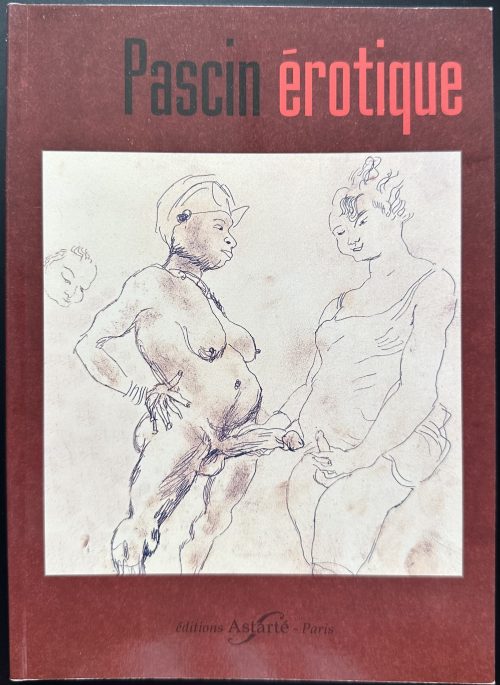 NEWCatalogue raisonné of Pascin's erotic drawings. Softcover, 21 x 15 cm, burgundy gloss pictorial paperback with lettering and vignettes, pp.: [1-3] 4-102 [2], illustrated throughout. Limited edition of 1,000 copies. Title-page: Pascin érotique | {round vignette} | éditions Astarté - Paris || Contributors: Alexandre Dupouy (French) Pascin, Jules [Pincas, Julius Mordecai] (French-Jewish, 1885 – 1930)
NEWCatalogue raisonné of Pascin's erotic drawings. Softcover, 21 x 15 cm, burgundy gloss pictorial paperback with lettering and vignettes, pp.: [1-3] 4-102 [2], illustrated throughout. Limited edition of 1,000 copies. Title-page: Pascin érotique | {round vignette} | éditions Astarté - Paris || Contributors: Alexandre Dupouy (French) Pascin, Jules [Pincas, Julius Mordecai] (French-Jewish, 1885 – 1930) -
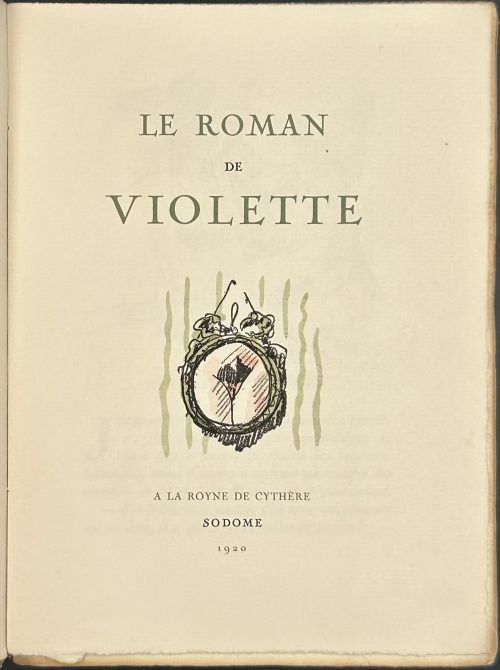 NEWSoftcover volume, 19.5 x 14.3 cm, olive French flapped wrappers, glassine dust cover, printed on laid paper (Hollande), outer and bottom margins untrimmed, some pages uncut; pagination: [2] blank, [i-iv] h.t./limit., t.p./blank, v-viii, 1-196 [197] [5], total 212 pages plus frontispiece; head- and tailpieces and in-text stencil-coloured etchings after Chéripoulos. Title-page (olive and black): LE ROMAN | DE | VIOLETTE | {vignette} | A LA ROYNE DE CYTHÈRE | SODOME | 1920 || Limitation: Cet ouvrage, achevé d'imprimer le cinq Janvier Mil Neuf Cent Vingt à trois cents exemplaires dont vingt-cinq exemplaires sur Japon Impérial contenant chacun un dessin original de Chéripoulos, numérotés de un à vingt-cinq; deux cent soixante-quinze exemplaires sur papier de Hollande, numérotés de vingt-six à trois cents; en plus cinq exemplaires de collaborateurs marqués de A à E. Le présent exemplaire porte le numéro 72. Edition: Printed on the 5th of January 1920 in 305 copies (№№ 1-25 on Japon Impérial, №№ 26-300 on Hollande, A–E for collaborators). Catalogue raisonné: Dutel III № 2339, p. 350. Contributors: Henriette de Mannoury d'Ectot [Henriette Nicolas Le Blanc] (French 1815 – 1899) Charles Auguste Edelmann [Chéripoulos] (French, 1879 – 1950).
NEWSoftcover volume, 19.5 x 14.3 cm, olive French flapped wrappers, glassine dust cover, printed on laid paper (Hollande), outer and bottom margins untrimmed, some pages uncut; pagination: [2] blank, [i-iv] h.t./limit., t.p./blank, v-viii, 1-196 [197] [5], total 212 pages plus frontispiece; head- and tailpieces and in-text stencil-coloured etchings after Chéripoulos. Title-page (olive and black): LE ROMAN | DE | VIOLETTE | {vignette} | A LA ROYNE DE CYTHÈRE | SODOME | 1920 || Limitation: Cet ouvrage, achevé d'imprimer le cinq Janvier Mil Neuf Cent Vingt à trois cents exemplaires dont vingt-cinq exemplaires sur Japon Impérial contenant chacun un dessin original de Chéripoulos, numérotés de un à vingt-cinq; deux cent soixante-quinze exemplaires sur papier de Hollande, numérotés de vingt-six à trois cents; en plus cinq exemplaires de collaborateurs marqués de A à E. Le présent exemplaire porte le numéro 72. Edition: Printed on the 5th of January 1920 in 305 copies (№№ 1-25 on Japon Impérial, №№ 26-300 on Hollande, A–E for collaborators). Catalogue raisonné: Dutel III № 2339, p. 350. Contributors: Henriette de Mannoury d'Ectot [Henriette Nicolas Le Blanc] (French 1815 – 1899) Charles Auguste Edelmann [Chéripoulos] (French, 1879 – 1950). -
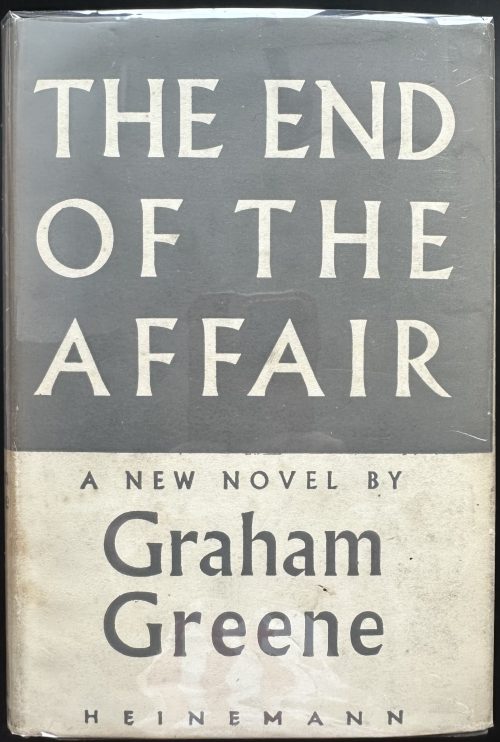 NEWHardcover volume, 19 x 13 cm, grey cloth with gilt lettering to spine, grey/cream dust jacket lettered throughout, price “10s 6d | NET” unclipped. Covers rubbed, dust jacket has a purple ink stain on the back bottom. Black ink inscription to recto ffl. Collation: a-o8 p10, total 122 leaves; pp.: [6] 1-237 [238]. 1st edition, 1st issue / Great Britain. Title-page: THE END OF THE | AFFAIR | by | GRAHAM GREENE | {publisher’s device} | — | WILLIAM HEINEMANN LTD | MELBOURNE :: LONDON :: TORONTO || Imprint: FIRST PUBLISHED 1951 | PRINTED IN GREAT BRITAIN | AT THE WINDMILL PRESS | KINGSWOOD, SURREY || Dedication: To C. (Catherine Walston, nee Crompton, American, 1925 – 1978) Contributors: Graham Greene (British, 1904 – 1991) William Henry Heinemann (Jewish-British, 1863 – 1920)
NEWHardcover volume, 19 x 13 cm, grey cloth with gilt lettering to spine, grey/cream dust jacket lettered throughout, price “10s 6d | NET” unclipped. Covers rubbed, dust jacket has a purple ink stain on the back bottom. Black ink inscription to recto ffl. Collation: a-o8 p10, total 122 leaves; pp.: [6] 1-237 [238]. 1st edition, 1st issue / Great Britain. Title-page: THE END OF THE | AFFAIR | by | GRAHAM GREENE | {publisher’s device} | — | WILLIAM HEINEMANN LTD | MELBOURNE :: LONDON :: TORONTO || Imprint: FIRST PUBLISHED 1951 | PRINTED IN GREAT BRITAIN | AT THE WINDMILL PRESS | KINGSWOOD, SURREY || Dedication: To C. (Catherine Walston, nee Crompton, American, 1925 – 1978) Contributors: Graham Greene (British, 1904 – 1991) William Henry Heinemann (Jewish-British, 1863 – 1920) -
 Iron tsuba of mokko form decorated with encircled family crests in low relief carving; niku from 3.0 mm in the centre to 4.0 mm at rim and full 1 mm raised uchikaeshi-mimi. Nobuie [信家] signature (hanare-mei) to the left of nakago-ana; on the reverse, to the right of nakago-ana, the inscription reads “62”, which may be how old the master was at the age of making the tsuba. Pewter or lead plugged hitsuana. In a wooden box, in a custom pouch. Size: H: 80 mm, W: 75, Th(c): 3.1 mm, Th(r): 4.0 mm Weight: 103.5 g
Iron tsuba of mokko form decorated with encircled family crests in low relief carving; niku from 3.0 mm in the centre to 4.0 mm at rim and full 1 mm raised uchikaeshi-mimi. Nobuie [信家] signature (hanare-mei) to the left of nakago-ana; on the reverse, to the right of nakago-ana, the inscription reads “62”, which may be how old the master was at the age of making the tsuba. Pewter or lead plugged hitsuana. In a wooden box, in a custom pouch. Size: H: 80 mm, W: 75, Th(c): 3.1 mm, Th(r): 4.0 mm Weight: 103.5 gSigned: Nobuie [信家] / 62
Probably the work of Shodai Nobuie (c. 1580).
Tokubetsu hozon certificate № 2002993 of the N.B.T.H.K., dated January 15, 2016. NOBUIE TSUBA by Steve Waszak The iron tsuba made by the two early Nobuie masters are regarded as the greatest sword guards ever made across hundreds of years of Japanese history. Only a small handful of other smiths' names are even mentioned in the same breath as that of Nobuie. Despite the well-deserved fame of the Nobuie name, virtually nothing is known with certainty about the lives of the two men who made the pieces carrying this name. They are thought to have been men of Owari Province, with the Nidai Nobuie also spending time in Aki Province at the end of the Momoyama Period. Two Nobuie tsubako are recognized. The man whom most consider to have been the Shodai signed his sword guards with finer and more elegantly inscribed characters than the smith seen by most as the Nidai. The term used to describe the mei of the Shodai is "hanare-mei" or "ga-mei," while that used to characterize the signature of the Nidai is "futoji-mei" or "chikara-mei." These terms refer to the fineness and grace of the Shodai's signature and the relatively more powerfully inscribed characters of the Nidai's. The Shodai is thought to have lived during the Eiroku and Tensho eras in the latter part of the 16th century, while the Nidai's years are considered to have been from Tensho into the Genna era. This locates both smiths well within the Golden Age of tsuba artists -- the Momoyama Period. Nobuie tsuba are esteemed and celebrated for the extraordinary beauty of their iron. The combination of the forging of the metal, the surface treatment by tsuchime and yakite married to powerfully expressive carving, the masterful manipulation of form, mass and shape, and the colour and patina of the iron makes Nobuie sword guards not only unique in the world of tsuba, but the greatest of the great. The sword guard here is a Shodai-made masterwork, done in mokko-gata form, a shape the early Nobuie smiths mastered to a degree unmatched by any others. The expanding of the mass of the tsuba from the seppa-dai to the mimi, increasing by 50% from the centre of the guard to the rim, creates a sense of exploding energy, which is then contained by the uchikaeshi-mimi, yielding a lightning-in-a-bottle effect of captured energy. The hammering the master has employed to finish the surface is subtle and sensitive, achieving a resonant profundity, and the deep blue-black colour -- augmented by a lustrous patina -- leaves the tsuba to positively glow in one's hand. In this piece, Nobuie has used a motif of several kamon, or family crests, each carved only lightly on the surface in a loose ring around the nakago-ana. Due to the shallow depth of this carving, together with the tsuchime finish of the plate, the effect is to leave the kamon with a sort of weathered appearance, recalling the prime aesthetic values of sabi and wabi, which had great circulation in the Tea Culture so ascendant in the Momoyama years. However, the effects of sabi and wabi expressed in the treatment described above are amplified and deepened by the color and patina of the iron, thereby adding yet another aesthetic value -- yuugen -- which is linked with the abiding mystery of the universe and one more — mono no aware — which alludes to the pathos of life's experiences and transitory nature. In short, this Nobuie tsuba joins poetry with power and therein exemplifies the unrivalled brilliance of Nobuie workmanship. -
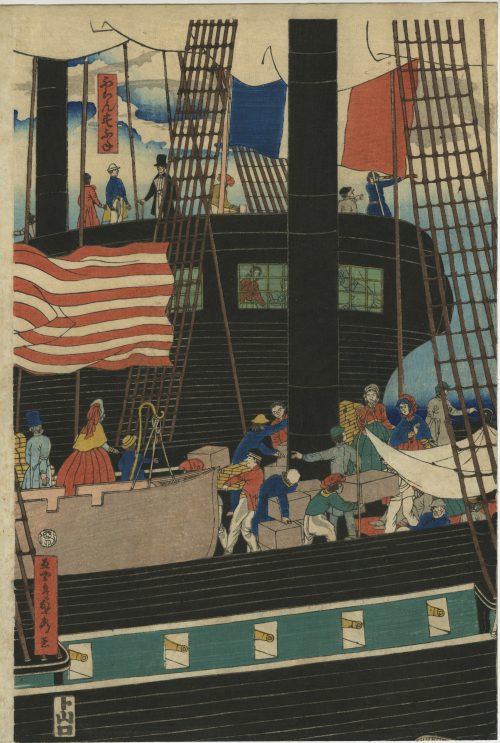 Utagawa Sadahide, a.k.a. Gountei Sadahide (Japanese, 1807 – c. 1878–1879), 五雲亭 貞秀, 歌川 貞秀, Yamaguchiya Tōbei, Yokohama kōeki seiyōjin nimotsu unsō no zu - Western traders loading cargo in Yokohama - 横浜交易西洋人荷物運送之圖, 1861, Woodblock print (nishiki-e); ink and color on paper, Horizontal Ōban Pentaptych: 5 x (37 x 25.5 cm), Alternative title: Picture of Western Traders at Yokohama Transporting Merchandise (Cat. Reisonée: Yokohama ukiyo-e, Yurindo, 1979: №50). Japanese pentaptych print shows an American ship in the harbor at Yokohama, Japan; small boats ferry cargo which is being carried up a gangplank contributing to the bustle of activity on the main deck. April, 1861. SOLD
Utagawa Sadahide, a.k.a. Gountei Sadahide (Japanese, 1807 – c. 1878–1879), 五雲亭 貞秀, 歌川 貞秀, Yamaguchiya Tōbei, Yokohama kōeki seiyōjin nimotsu unsō no zu - Western traders loading cargo in Yokohama - 横浜交易西洋人荷物運送之圖, 1861, Woodblock print (nishiki-e); ink and color on paper, Horizontal Ōban Pentaptych: 5 x (37 x 25.5 cm), Alternative title: Picture of Western Traders at Yokohama Transporting Merchandise (Cat. Reisonée: Yokohama ukiyo-e, Yurindo, 1979: №50). Japanese pentaptych print shows an American ship in the harbor at Yokohama, Japan; small boats ferry cargo which is being carried up a gangplank contributing to the bustle of activity on the main deck. April, 1861. SOLD -
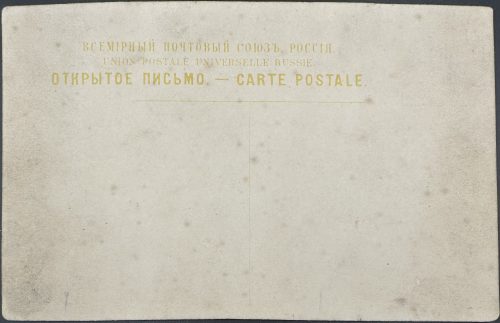 Ten postcards 90 x 140 mm, text in yellow "ВСЕМIРНЫЙ ПОЧТОВЫЙ СОЮЗЪ. РОССIЯ. | UNION POSTALE UNIVERSELLE RUSSIE. | ОТКРЫТОЕ ПИСЬМО. — CARTE POSTALE. || On the reverse, a blue ink woodcut image is printed in the upper left corner, and a идгу штл inscription is in the bottom centre. Holding the postcard against the backlight reveals a hidden image of an indecent nature (erotic). The use of Latin characters "R" and "N" instead of Russian "Р" and "Н" suggests that the cards were produced in Europe, probably in France. Inscriptions: 1. ПЕRВЫЕ ДNИ; 2. ПОRА ЛЮБВИ; 3. ВЪ ЛЮДИ; 4. КЪ "СВОБОДNОМУ ИСКУССТВУ"; 5. "СВОБОДNЫЙ ТRУДЪ; 6. БЕЗЪ ГОRЯ И ПЕЧАЛИ; 7. NАЗАДЪ КЪ "СВОБОДNОЙ ЛЮБВИ"; 8. ВСЕ ЧТО ОСТАЛОСЬ!; 9. БЕЗЪ КRОВА И ПRИСТАNИЩА; 10. ИЗЪ ЗА ХЛѢБА.
Ten postcards 90 x 140 mm, text in yellow "ВСЕМIРНЫЙ ПОЧТОВЫЙ СОЮЗЪ. РОССIЯ. | UNION POSTALE UNIVERSELLE RUSSIE. | ОТКРЫТОЕ ПИСЬМО. — CARTE POSTALE. || On the reverse, a blue ink woodcut image is printed in the upper left corner, and a идгу штл inscription is in the bottom centre. Holding the postcard against the backlight reveals a hidden image of an indecent nature (erotic). The use of Latin characters "R" and "N" instead of Russian "Р" and "Н" suggests that the cards were produced in Europe, probably in France. Inscriptions: 1. ПЕRВЫЕ ДNИ; 2. ПОRА ЛЮБВИ; 3. ВЪ ЛЮДИ; 4. КЪ "СВОБОДNОМУ ИСКУССТВУ"; 5. "СВОБОДNЫЙ ТRУДЪ; 6. БЕЗЪ ГОRЯ И ПЕЧАЛИ; 7. NАЗАДЪ КЪ "СВОБОДNОЙ ЛЮБВИ"; 8. ВСЕ ЧТО ОСТАЛОСЬ!; 9. БЕЗЪ КRОВА И ПRИСТАNИЩА; 10. ИЗЪ ЗА ХЛѢБА. -
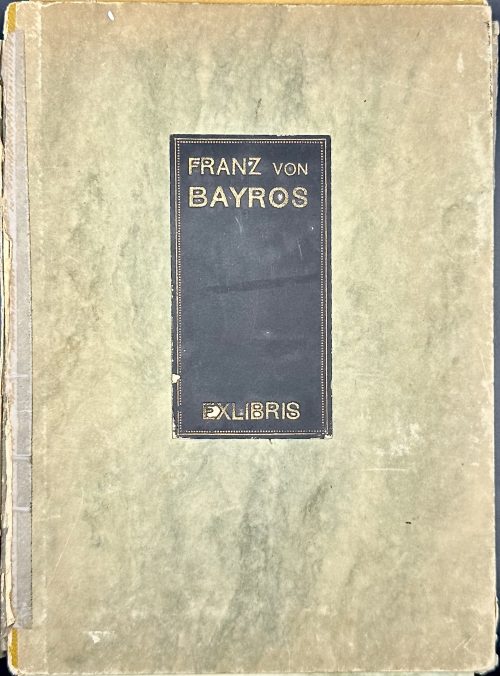 A set of 49 prints, heliogravures and etchings, tipped-in on 285 x 257 mm grey cards, in a green marbled folder with a gilt-lettered black label to the front. No publisher, no place, no year (s.l., s.n., s.d.), printed in circa 1910.
A set of 49 prints, heliogravures and etchings, tipped-in on 285 x 257 mm grey cards, in a green marbled folder with a gilt-lettered black label to the front. No publisher, no place, no year (s.l., s.n., s.d.), printed in circa 1910.- Vlastimil Blažek (Czech, 1878 – 1950): heliogravure, sheet 180 x 137 mm, plate 152 x 114 mm; laid paper, black sepia ink; unsigned.
- Ex libris Gerhard Wunderlich (architect in Dresden): heliogravure, sheet 205 x 150 mm, plate 158 x 115 mm; wove paper, brown sepia ink; inscription: heliogravure, sheet 180 x 137 mm, plate 152 x 114 mm; laid paper, sepia ink; inscription to top “Es ist alles so eng”; signed “F (backwards). Bayros”.
- Ex libris William Lipka: heliogravure, sheet 140 x 125 mm, plate 112 x 98 mm; laid paper, black sepia ink; signature hardly legible.
- Nikolaus Schindler (amateur photographer in Vienna): heliogravure, sheet 142 x 150 mm, plate 110 x 117 mm; laid paper, black sepia ink; unsigned.
- Sussy de Coiquard: heliogravure, sheet 160 x 140 mm, plate 128 x 110 mm; laid paper, black sepia ink; unsigned.
- Illegible, looks like “Vielluer Febréy”: heliogravure, sheet 120 x 109 mm, plate 93 x 85 mm; laid paper, black, sepia ink; signed “F (backwards). Bayros:”.
- Ex libris Erich Liebermann-Rosswiese (Greman-Jewish, 1886 – 1942): heliogravure, sheet 180 x 139 mm, plate 118 x 88 mm; wove paper, black sepia ink; unsigned.
- Ex libris Dr. phil. Rudolf Ludwig: before letters, heliogravure, sheet 150 x 132 mm, plate 120 x 110 mm; laid paper, black sepia ink; unsigned. See [LIB-3258.2023] John Cleland. Die Memoiren der Fanny Hill. — Paphos [i.e. Vienna]: C. W. Stern, 1906.
- Unidentified: before letters, heliogravure, sheet 150 x 115 mm, plate 113 x 88 mm; laid paper, black sepia ink; signed “F. Bayros” in the manuscript. Circumstantial evidence tells that this bookplate belongs to someone A.W.(Artur Wolf). See №22.
- Lulu. Monachia. Gest. v. Ritter Dialekt und Junker Erich: heliogravure, sheet 204 x 152 mm, plate 160 x 118 mm; wove paper, black sepia ink; unsigned. See №20.
- Kellner Jstván: (István): heliogravure, sheet 118 x 100 mm, plate 85 x 70 mm; laid paper, black sepia ink; signed “Franz Bayros” in the script (hardly legible).
- Adyton: heliogravure, sheet 170 x 130 mm, plate 113 x 85 mm; wove paper, black, sepia ink; signed “F (backwards). Bayros”.
- 13.Ex libris George Arthur Buhl (American, 1883 – 1959): heliogravure, sheet 166 x 140 mm, plate 120 x 92 mm; wove paper, black sepia ink; inscription “!I will! | !And I can!”; bust inscribed “T. Carlyle”; signed “F (backwards). Bayros” (hardly legible).
- Ex-Libris Heinrich und Lise Fuhrmann: heliogravure, sheet 165 x 149 mm, plate 120 x 103 mm; wove paper, black sepia ink; signed “F (backward). Bayros”; inscription “So schaff ich am sausenden Webstuhl der Zeit und wirke der Gottheit lebendiges Kleid” (from ‘Faust’ by Goethe).
- Ex libris Gerhard Wunderlich (architect in Dresden): heliogravure, sheet 165 x 137 mm, plate 135 x 105 mm; laid paper, black, sepia ink; signed “F (backwards). Bayros”.
- Ex Libris Walther u. Amelia Fahrenhorst; Walter Fahrenhorst (German, 1871 – 1938): heliogravure, sheet 165 x 140 mm, plate 128 x 95 mm; wove paper, black sepia ink; signed “F. Bayros” in the manuscript. The inscription behind the strings: NITOR (lat. beauty, glamour).
- Ex Libris Margot Lewknecht; heliogravure, sheet 145 x 140 mm, plate 128 x 118 mm; laid paper, black sepia ink; signed “F. Bayros”.
- Ex Libris Walther Heinisch (publisher in Carlsbad); heliogravure, sheet 185 x 145 mm, plate 140 x 110 mm; wove paper, sanguine; male bust with an inscription to the base: “Arnold Boeklin” / Arnold Böcklin (Swiss, 1827 – 1901); inscription: “mit gêru scal man geba infâhan” – a line from Hildebrandslied, the earliest poetic text in German. Unsigned.
- Bookplate with music score GGDBGC; heliogravure, sheet 125 x 135 mm, plate 100 x 110 mm, with monogram «HCJ»; laid paper, brown sepia ink; signed “F. Bayros”.
- Bookplate with inscription: Lulu aus Praga | Gest v. Ritter Dialekt / Monachia / Monachia / und Junker Erich; heliogravure, sheet 182 x 147 mm, plate 160 x 120 mm, image 122 x 105 mm; wove paper, bluish-black sepia ink; unsigned. See №10.
- Bookplate, no inscription; heliogravure, laid paper, sepia ink, sheet 148 x 127 mm, image 84 x 79 mm; signed F. Bayros in the manuscript beneath the image.
- Ex libris Artur Wolf: heliogravure, laid paper, sepia ink, sheet 170 x 150 mm, image 120 x 105 mm; signed F. Bayros in the manuscript to the frame of the image. See №9.
- Ex Libris E. K. Weigl: heliogravure, laid paper, sepia ink, sheet 139 x 121 mm, plate 112 x 97 mm; unsigned; inscription above male portrait: “LEONARDO”.
- Ex libris Dr. A. Bergmann: heliogravure, wove paper, sepia ink; sheet 180 x 140 mm, plate 130 x 105 mm; signed F. Bayros in the manuscript.
- Grete Cäcilie (monogram “PS”): heliogravure, laid paper, sepia ink, sheet 161 x 130 mm, plate 128 x 103 mm, signature illegible.
- Emma Steigleder: heliogravure, laid paper, black ink, sheet 181 x 141 mm, plate 158 x 117 mm, signed F. Bayros in the manuscript. Inscription “Si vis amari, ama! Seneca” [If you want to be loved, love] to the attic of the arch.
- Bruno Fischer: heliogravure, laid paper, sepia ink, sheet 186 x 145 mm, plate 155 x 116 mm, signed “F (backward). Bayros”. Inscription to bottom “Gehl Weck’ ihn nicht auf seien wir froh dass er einmal schläft!”
- Harnasch: heliogravure, wove paper, sepia ink; unsigned; sheet 140 x 132 mm, plate 100 x 85 mm; unsigned.
- Eduard Klampfl: heliogravure, laid paper, sepia ink, sheet 165 x 145 mm, plate 135 x 110 mm, signed “F (backwards). Bayros”; portrait bust of the composer Richard Wagner (German, 1813 –1883).
- Jorge Monsalvatje: heliogravure, wove paper, sepia ink; sheet 189 x 160 mm, plate 150 x 115 mm; signed F. Bayros in the manuscript.
- E. K. W.: wove paper, sepia ink; sheet 150 x 120 mm; signed “Bayros”.
- Unidentified bookplate: wove paper, sepia ink; sheet 150 x 120 mm; signed “F. Bayros 09” in the manuscript.
- Ex-Libris Helene and Emil Lemberger: heliogravure (or soft ground etching), laid paper, sepia ink, sheet 180 x 163 mm, plate 150 x 130 mm, signed “F. Bayros” in the manuscript.
- M. Z.: wove paper, sepia ink; sheet 130 x 170 mm, plate 90 x 120 mm; signed “F (backwards) Bayros”.
- Ex libris Frankl Frigyes Vilmos: heliogravure (or soft ground etching), laid paper, sepia ink, sheet 140 x 148 mm, unsigned. Frigyes Frankl, born in Tejfalu, Szlovákia, died in 1943.
- Ex libris Anton Bürck: heliogravure, wove paper, sepia ink; sheet 170 x 137 mm, plate 123 x 104 mm; unsigned. Anton Burck (German,1881 – 1951) of Palatinate, Bavaria.
- Aus den büchern A. W.: heliogravure, laid paper, sepia ink, sheet 152 x 136 mm, plate 120 x 105 mm, signed “F. Bayros” in the manuscript.
- Ex libris Hans Hickl: heliogravure, laid paper, sepia ink, sheet 150 x 125 mm, plate 115 x 95 mm, signed “Ω”.
- Ex libris Karl Wehle: soft ground etching, laid paper, brown sepia ink, sheet 107 x 90 mm, plate 80 x 65 mm, inscription “Gut!” in the centre; unsigned. Karl Wehle (Austrian, 1901 – 1933)
- Ex libris Dr. Paul Berger: etching, laid paper, black ink, sheet 140 x 115 mm, plate 115 x 85 mm, signed “F (backwards). Bayros”.
- Unidentified bookplate: etching, laid paper, black ink, sheet 145 x 115 mm, plate 85 x 70 mm, unsigned.
- Ex Bibliotheca Erotica Carl Georg von Maassen: soft ground etching, india paper, black ink, sheet 76 x 78 mm, signed “FB”.
- Ex Bibliotheca Erotica Carl Georg von Maassen: soft ground etching, india paper, black ink, sheet 79 x 79 mm, signed “F. von Bayros”.
- Paul Mixa: soft ground etching, laid paper, sanguine ink, sheet 122 x 111 mm, plate 90 x 85 mm, inscription: “Gerne hör’ich wenn du singest und ich horche wenn du schweigest” [I like to hear when you sing and I listen when you are silent].
- Ex libris Drs Q. M. Vyskocil.: etching, laid paper, sanguine ink, sheet 141 x 115 mm, plate 115 x 75 mm, inscription: “MIT REINEN HAENDEN” [with pure hands], signed “F. Bayros” in the manuscript.
- Ex libris Andrée Bearn de Riquer: soft ground etching, laid paper, sanguine ink, sheet 136 x 88 mm, plate 100 x 62 mm, signed “F (backwards). Bayros”. Andrée Béarn [Marguerite Laborde] (French, 1880 – 1973), spouse of Alexandre de Riquer (Catalan, 1856 – 1920).
- Ex musicis Drs Blažek VL: etching, wove paper, sanguine ink, sheet 141 x 116 mm, plate 115 x 90 mm, inscription: “MIT REINEN HAENDEN” [with pure hands], signed “F. Bayros” in the manuscript. See Vlastimil Blažek (Czech, 1878 – 1950) № 1 in this series.
- Ex libris Paul Lindenberg: etching, wove paper, sanguine ink, sheet 130 x 114 mm, plate 95 x 90 mm, image 80 x 72 mm, inscription: “ad pios usus” (for pious uses); signed with monogram “F (backwards). B”.
- Unidentified bookplate: heliogravure, laid paper, sanguine ink, sheet 150 x 131 mm, plate 120 x 100 mm, signed “F. Bayros” in the manuscript.
-
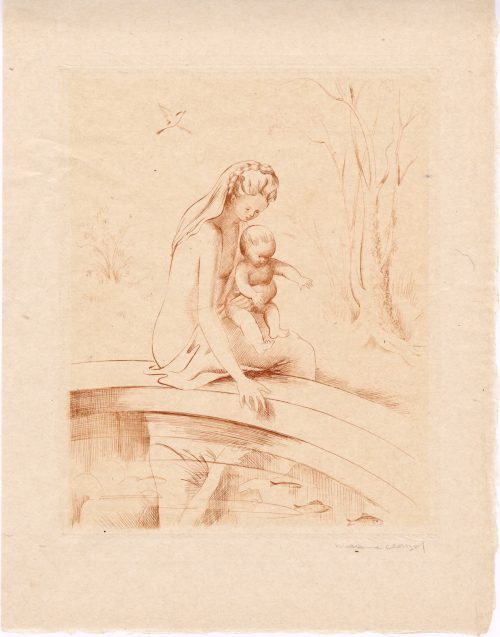 Set of 10 etchings (9 in passe-partout) printed in sanguine on the mother of pearl paper (japon nacre) from the album of 12 prints titled “Jeunesse”, presented by Gérard D'Houville (pen name of Marie de Régnier, née de Heredia) and published by La Tradition in 1945. It was a limited edition of 532 copies, some coloured on Arches paper and some as these set. Plates signed by the artist in pencil below the plate mark. The album cover is missing. Complete data for the album: JEUNESSE | 12 EAUX-FORTES ORIGINALES | DE | MARIANNE CLOUZOT | PRÉSENTÉES | PAR | GÉRARD D'HOUVILLE | {publisher’s device} | LA TRADITION | 1945 || Dimensions: mat 330 x 255 mm; window 225 x 180 mm; sheet 280 x 220 mm; plate 220 x 170 mm. Contributor: Martin van Maële [Martin, Maurice François Alfred] (French, 1863 – 1926)
Set of 10 etchings (9 in passe-partout) printed in sanguine on the mother of pearl paper (japon nacre) from the album of 12 prints titled “Jeunesse”, presented by Gérard D'Houville (pen name of Marie de Régnier, née de Heredia) and published by La Tradition in 1945. It was a limited edition of 532 copies, some coloured on Arches paper and some as these set. Plates signed by the artist in pencil below the plate mark. The album cover is missing. Complete data for the album: JEUNESSE | 12 EAUX-FORTES ORIGINALES | DE | MARIANNE CLOUZOT | PRÉSENTÉES | PAR | GÉRARD D'HOUVILLE | {publisher’s device} | LA TRADITION | 1945 || Dimensions: mat 330 x 255 mm; window 225 x 180 mm; sheet 280 x 220 mm; plate 220 x 170 mm. Contributor: Martin van Maële [Martin, Maurice François Alfred] (French, 1863 – 1926) -
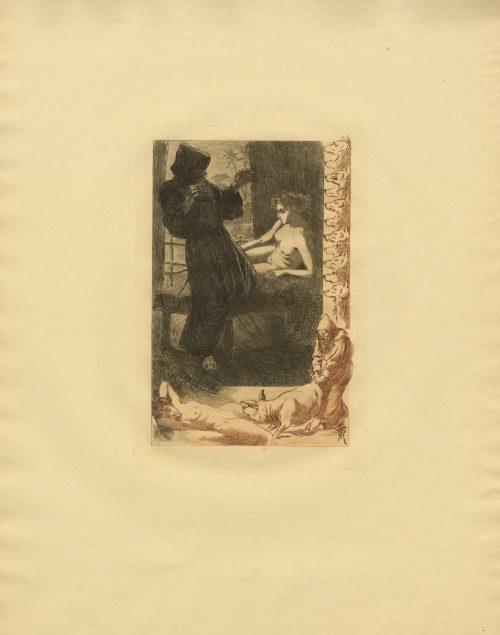 Set of 21 etchings by Martin van Maele for the English edition of ‘Thais’ by Anatole France published in London by Charles Carrington in 1901. Printed on vowe paper without a watermark in two colours with the black image and sepia historiated border. All etchings are inscribed with the artist's monogram; one of the etchings bears inscriptions ORGUEIL, LUXURE, DOUTE (mirror image). Dimensions: sheet: 317 x 250 mm; plate: 170 x 115 mm; image: 155 x 100 mm. Catalogue raisonné: S. A. Perry: № 64. Per Perry, the edition was printed in 500 copies on 'handmade paper watermarked 'Van Gelder'. Contributor: Martin van Maële [Martin, Maurice François Alfred] (French, 1863 – 1926)
Set of 21 etchings by Martin van Maele for the English edition of ‘Thais’ by Anatole France published in London by Charles Carrington in 1901. Printed on vowe paper without a watermark in two colours with the black image and sepia historiated border. All etchings are inscribed with the artist's monogram; one of the etchings bears inscriptions ORGUEIL, LUXURE, DOUTE (mirror image). Dimensions: sheet: 317 x 250 mm; plate: 170 x 115 mm; image: 155 x 100 mm. Catalogue raisonné: S. A. Perry: № 64. Per Perry, the edition was printed in 500 copies on 'handmade paper watermarked 'Van Gelder'. Contributor: Martin van Maële [Martin, Maurice François Alfred] (French, 1863 – 1926) -
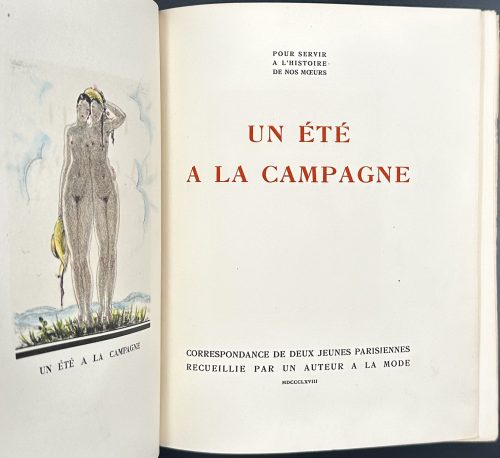 Softcover, 228 x 180 mm, tan French flapped wrappers with red lettering to front[1-4, owner’s glassine dustcover, top edge trimmed, printed on thick wove paper without a watermark; pp.: ffl [1-4 h.t., t.p.] 5-154 [2 blanks] colophon to back ffl recto, plus 12 plates with hand-coloured lithographs, extraneous to collation. Pencil and pigment drawing to h.t. signed “J. D’A” with gift manual inscription “A Monsieur et Madame Chalamel [sic] ce tardif mais sincère souvenir de sympathie”, signed “J et Y D’A.” Etching bookplate to front ffl recto: “EX LIBRIS PIERRE CHALLAMEL | JE FONCE DANS LE BROUILLARD”, signed “J A M” (Jean-Adrien Mercier). The signature J. D’A stands for Jean d’Angers, while Y D’A stands for Jean-Adrien’s wife Yvonne (1902—1999), nicknamed Zizi; they married in 1927. According to J.-P. Dutel, the stated illustrator of this edition, Jean d’Angers is indeed Jean-Adrien Mercier. The text belongs to Gustav Droz and, possibly, Auguste Poulet-Malassis. Limitation: the book was printed for subscribers in 30 copies on Japon Impériale paper (№№ 1-30) and 250 copies on vélin du Marais paper (№№ 31-280). This copy bears № 123 and was presented as a gift by the artist and his wife to Pierre Challamel. Title-page (red and black): POUR SERVIR | A L'HISTOIRE | DE NOS MŒURS | UN ÉTÉ | A LA CAMPAGNE | CORRESPONDANCE DE DEUX JEUNES PARISIENNES | RECUEILLIE PAR UN AUTEUR A LA MODE | MDCCCLXVIII || Catalogue raisonné: Dutel III № 2546; honesterotica. Provenance: Pierre Challamel (French, 20th century) Contributors: Gustave Droz (French, 1832 – 1895) – author (presumable). Auguste Poulet-Malassis (French, 1825 – 1878) – author (presumable). Jean-Adrien Mercier (French, 1899 – 1995) – artist. Micro photo of the lithography:
Softcover, 228 x 180 mm, tan French flapped wrappers with red lettering to front[1-4, owner’s glassine dustcover, top edge trimmed, printed on thick wove paper without a watermark; pp.: ffl [1-4 h.t., t.p.] 5-154 [2 blanks] colophon to back ffl recto, plus 12 plates with hand-coloured lithographs, extraneous to collation. Pencil and pigment drawing to h.t. signed “J. D’A” with gift manual inscription “A Monsieur et Madame Chalamel [sic] ce tardif mais sincère souvenir de sympathie”, signed “J et Y D’A.” Etching bookplate to front ffl recto: “EX LIBRIS PIERRE CHALLAMEL | JE FONCE DANS LE BROUILLARD”, signed “J A M” (Jean-Adrien Mercier). The signature J. D’A stands for Jean d’Angers, while Y D’A stands for Jean-Adrien’s wife Yvonne (1902—1999), nicknamed Zizi; they married in 1927. According to J.-P. Dutel, the stated illustrator of this edition, Jean d’Angers is indeed Jean-Adrien Mercier. The text belongs to Gustav Droz and, possibly, Auguste Poulet-Malassis. Limitation: the book was printed for subscribers in 30 copies on Japon Impériale paper (№№ 1-30) and 250 copies on vélin du Marais paper (№№ 31-280). This copy bears № 123 and was presented as a gift by the artist and his wife to Pierre Challamel. Title-page (red and black): POUR SERVIR | A L'HISTOIRE | DE NOS MŒURS | UN ÉTÉ | A LA CAMPAGNE | CORRESPONDANCE DE DEUX JEUNES PARISIENNES | RECUEILLIE PAR UN AUTEUR A LA MODE | MDCCCLXVIII || Catalogue raisonné: Dutel III № 2546; honesterotica. Provenance: Pierre Challamel (French, 20th century) Contributors: Gustave Droz (French, 1832 – 1895) – author (presumable). Auguste Poulet-Malassis (French, 1825 – 1878) – author (presumable). Jean-Adrien Mercier (French, 1899 – 1995) – artist. Micro photo of the lithography:
Micro photo of the original drawing: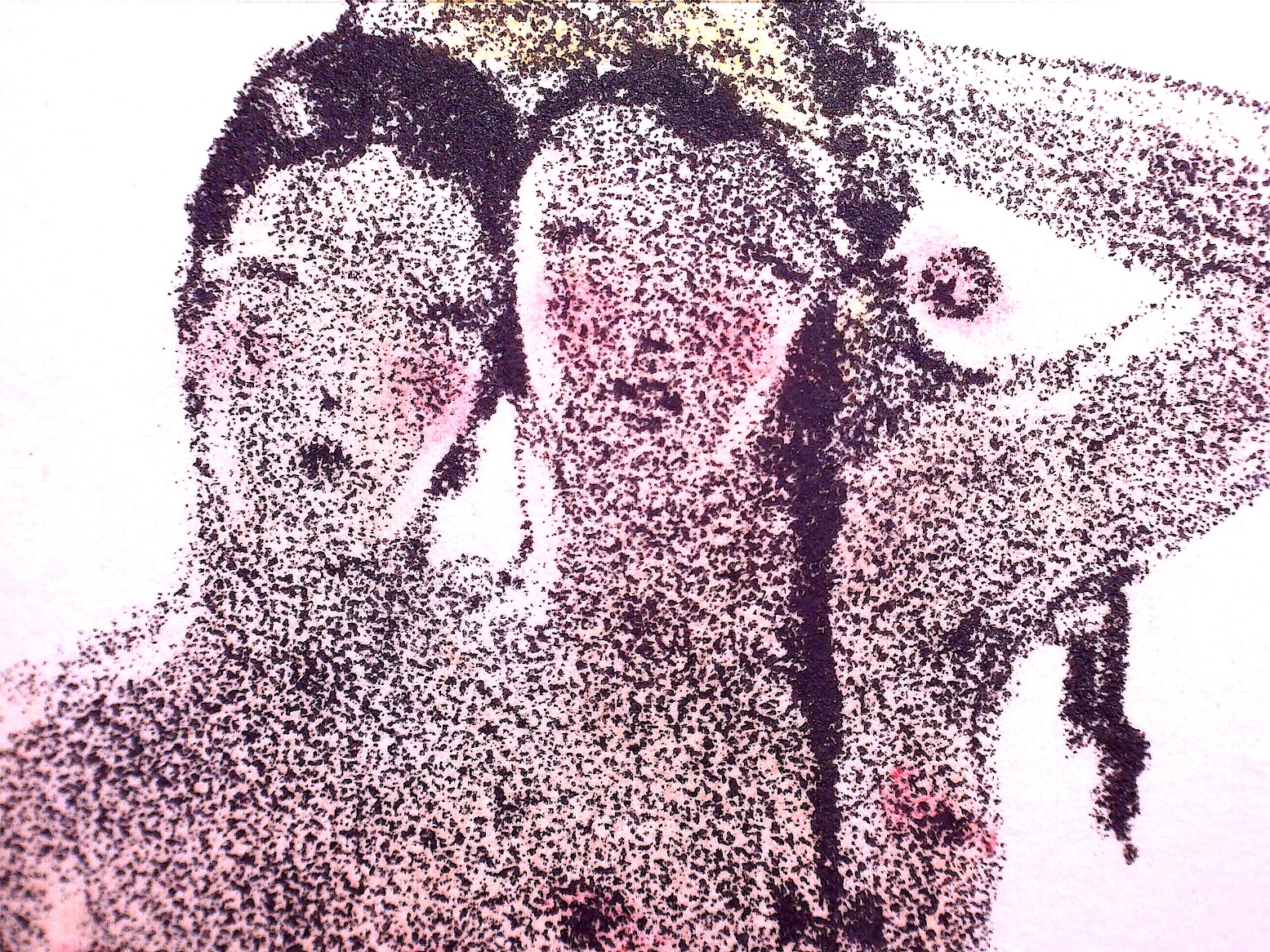
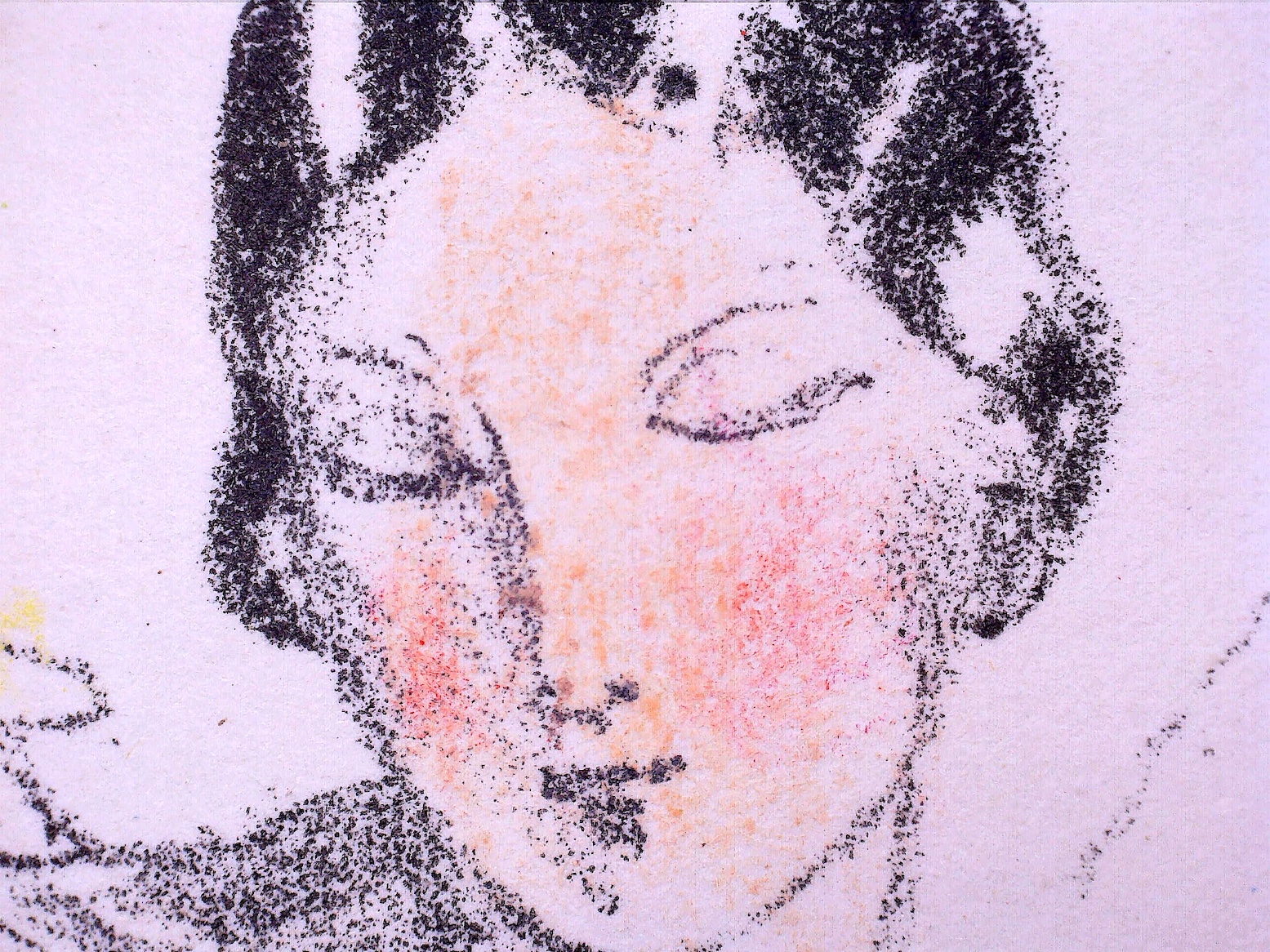
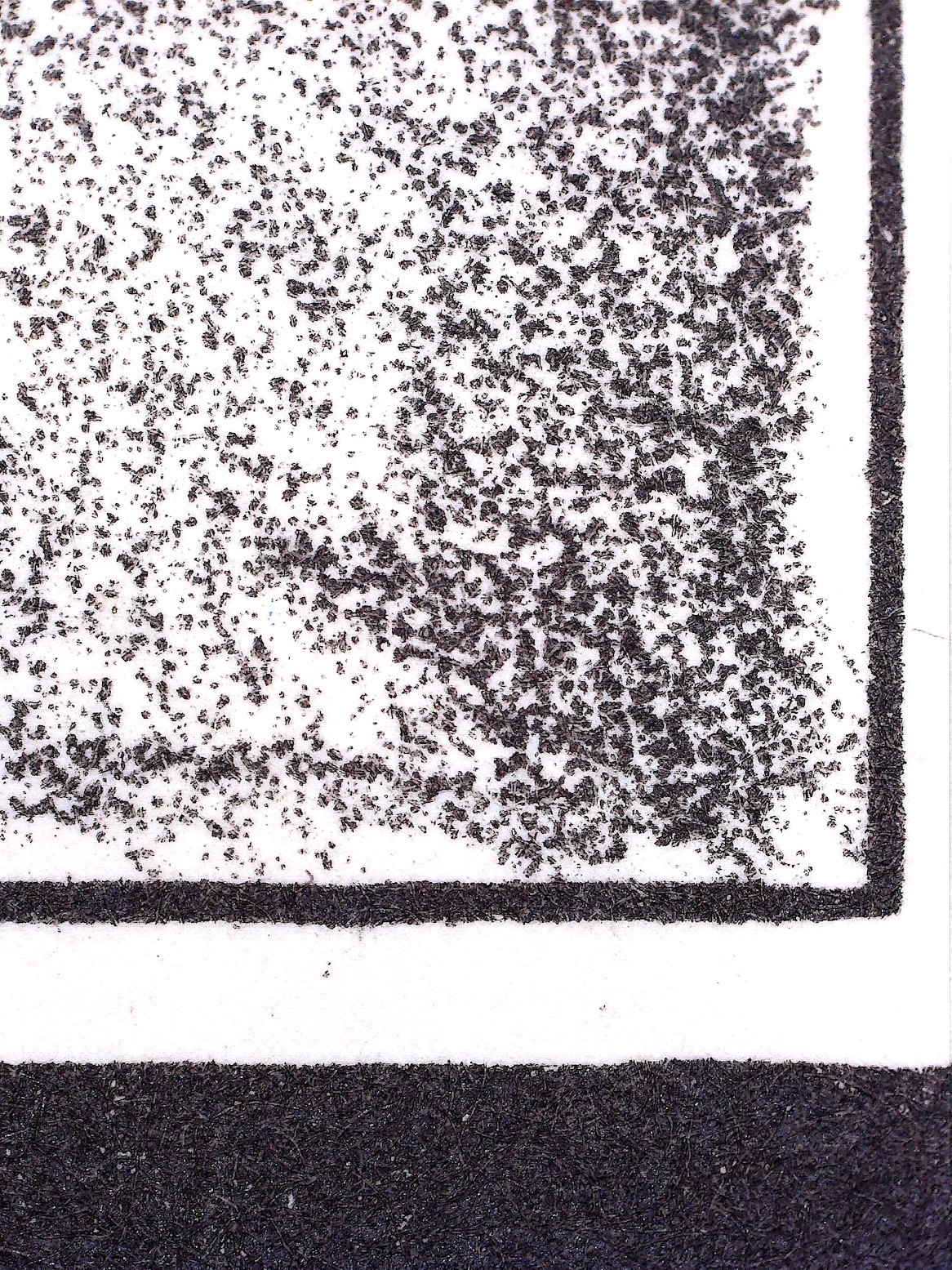
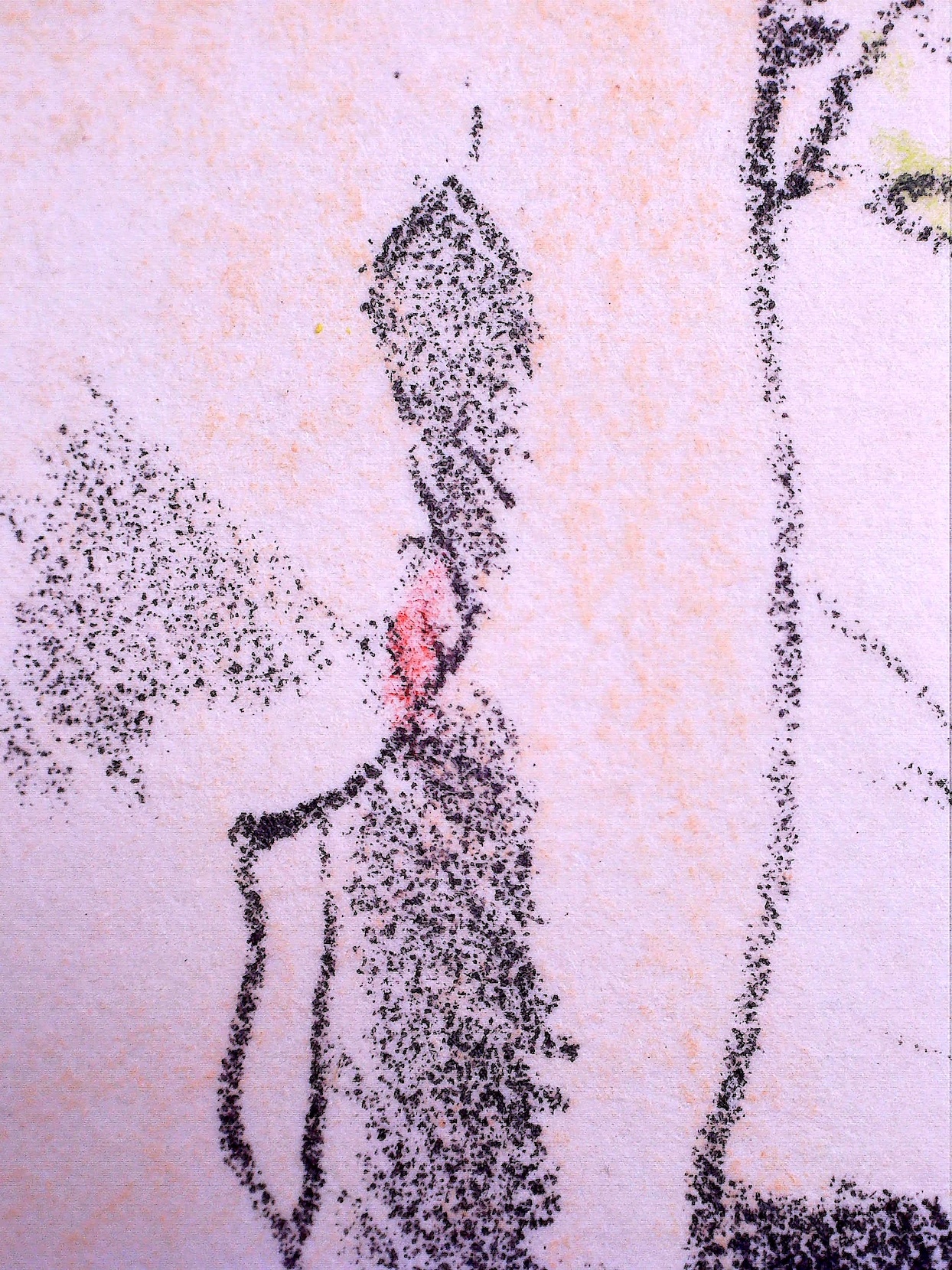
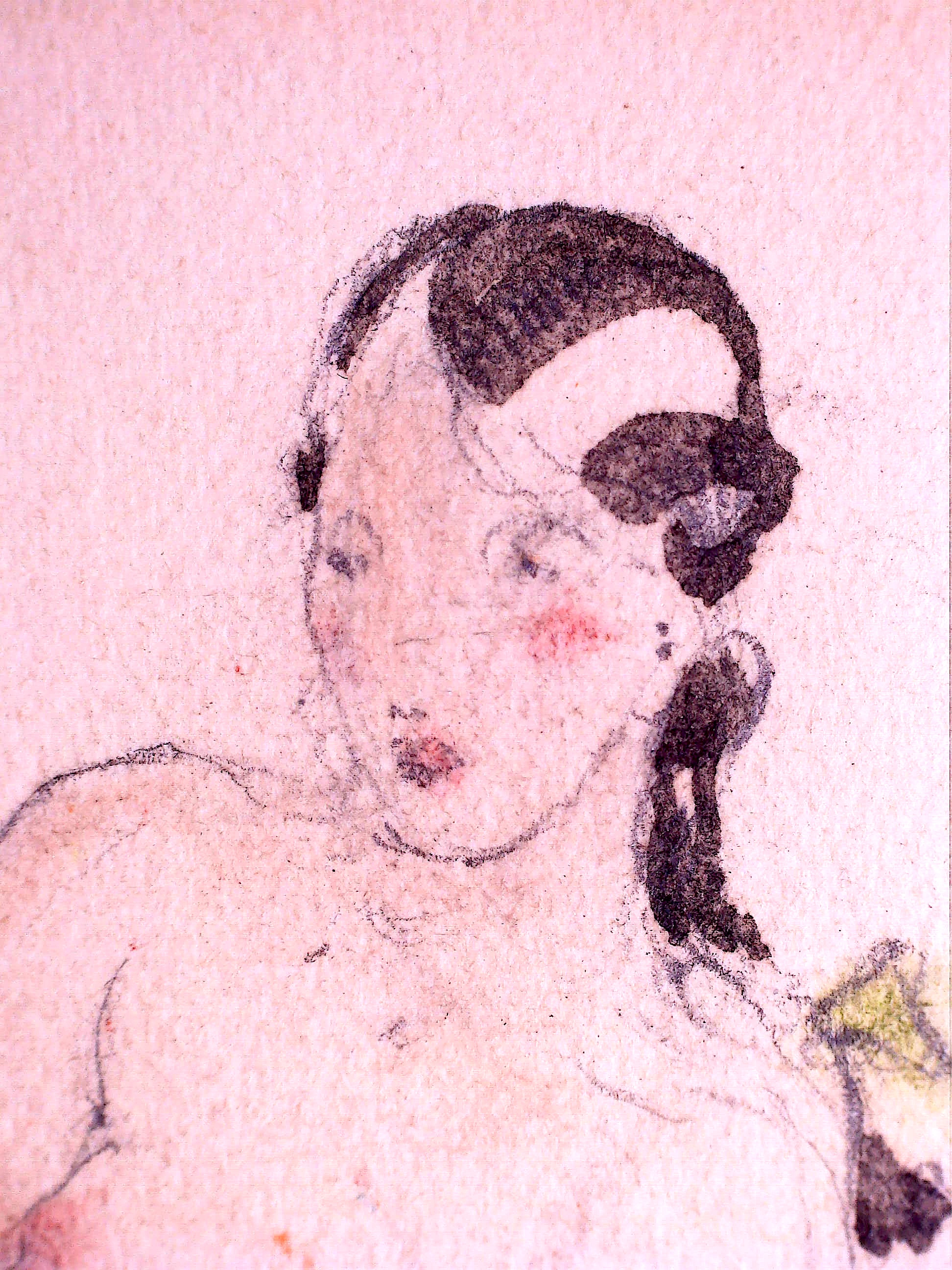
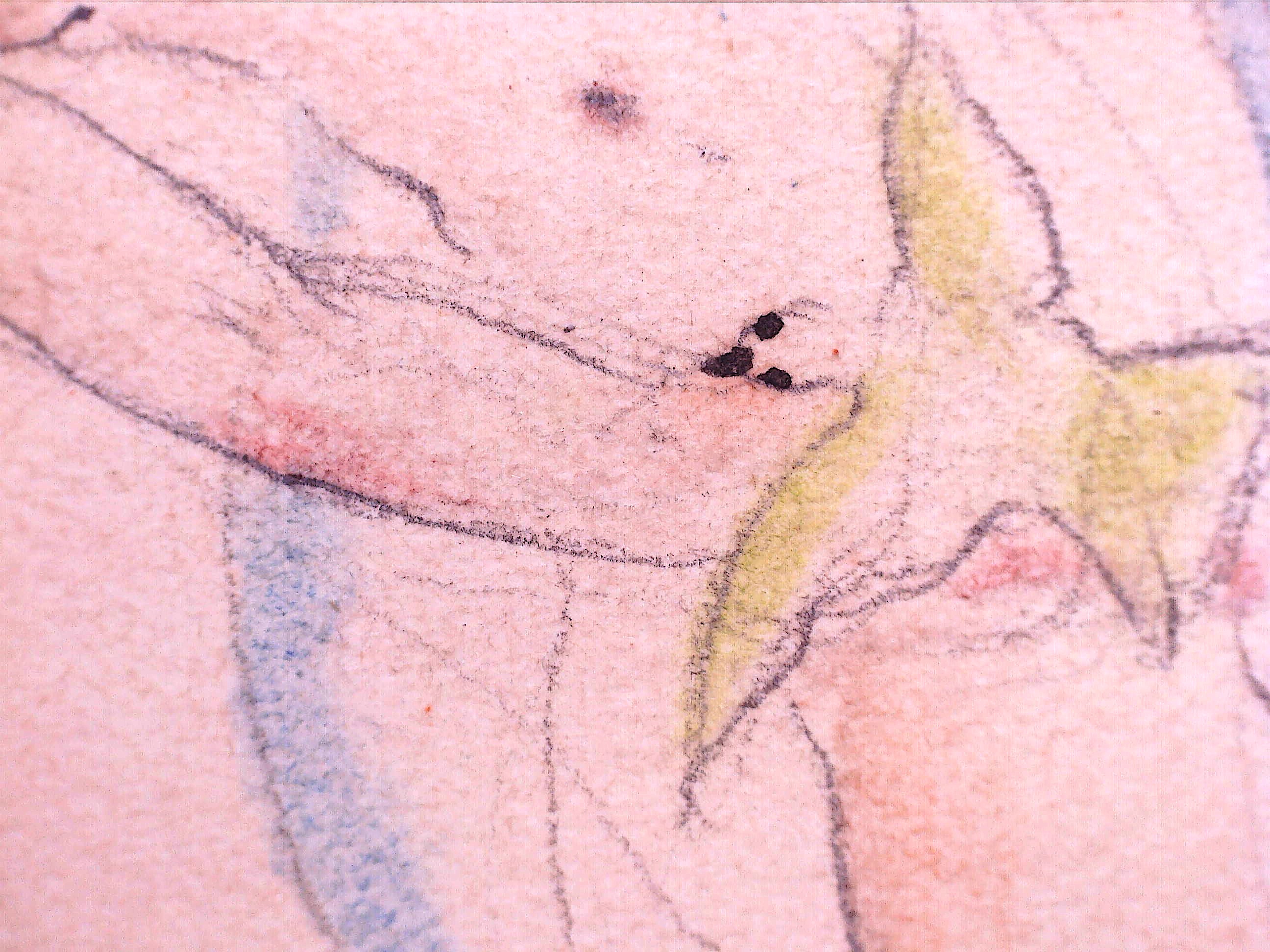
-
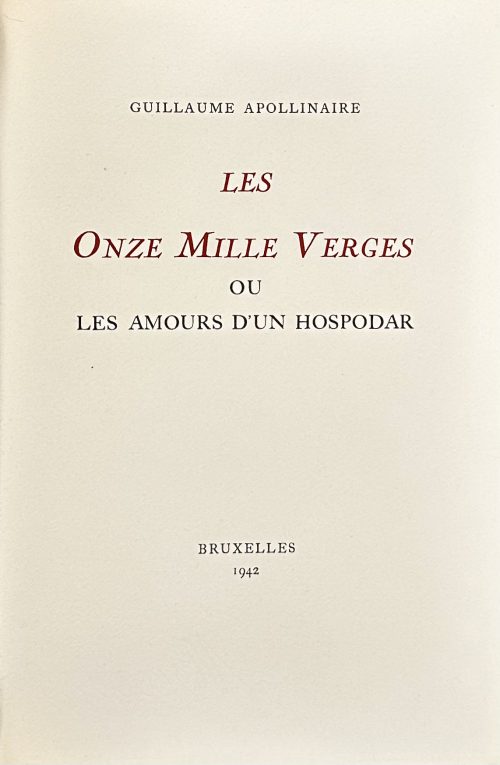 Softcover, 257 x 168 mm, publisher’s cream French flapped wrappers with red lettering to front in a beige double slipcase, printed on wove paper watermarked “Marais” in italic script; edges untrimmed; pp.: [8] [2] [1] 2-130 [131] [3]; collated 4to as 184, 72 leaves incl. those in the wrappers, plus 9 photomechanical stencil-coloured plates extraneous to collation and 9 b/w headpieces (in-text etchings) after anonymous artist. According to the seller and J.-P. Dutel: “In-8 of 130 pages... Illustrated with 10 full-page in colour and some headbands. Limited edition of 500 copies on vélin du Marais". Title-page (red and black): GUILLAUME APOLLINAIRE | LES | ONZE MILLE VERGES | OU | LES AMOURS D'UN HOSPODAR | BRUXELLES | 1942 || Limitation: Il a été tiré de cet ouvrage réservé uniquement aux souscripteurs particuliers 500 exemplaires tous sur vélin du marais. Exemplaire n° 147. Edition: The clandestine edition on vélin de Marais paper limited to 500 copies for subscribers only; this copy is № 147. Catalogue raisonné: Dutel III № 2109. In my copy, similarly to the one of STEVE M., it is only 9 colour plates, while Dutel sites 10. Author: Guillaume Apollinaire (French, 1880 – 1918). Micro photo of a colour plate:
Softcover, 257 x 168 mm, publisher’s cream French flapped wrappers with red lettering to front in a beige double slipcase, printed on wove paper watermarked “Marais” in italic script; edges untrimmed; pp.: [8] [2] [1] 2-130 [131] [3]; collated 4to as 184, 72 leaves incl. those in the wrappers, plus 9 photomechanical stencil-coloured plates extraneous to collation and 9 b/w headpieces (in-text etchings) after anonymous artist. According to the seller and J.-P. Dutel: “In-8 of 130 pages... Illustrated with 10 full-page in colour and some headbands. Limited edition of 500 copies on vélin du Marais". Title-page (red and black): GUILLAUME APOLLINAIRE | LES | ONZE MILLE VERGES | OU | LES AMOURS D'UN HOSPODAR | BRUXELLES | 1942 || Limitation: Il a été tiré de cet ouvrage réservé uniquement aux souscripteurs particuliers 500 exemplaires tous sur vélin du marais. Exemplaire n° 147. Edition: The clandestine edition on vélin de Marais paper limited to 500 copies for subscribers only; this copy is № 147. Catalogue raisonné: Dutel III № 2109. In my copy, similarly to the one of STEVE M., it is only 9 colour plates, while Dutel sites 10. Author: Guillaume Apollinaire (French, 1880 – 1918). Micro photo of a colour plate: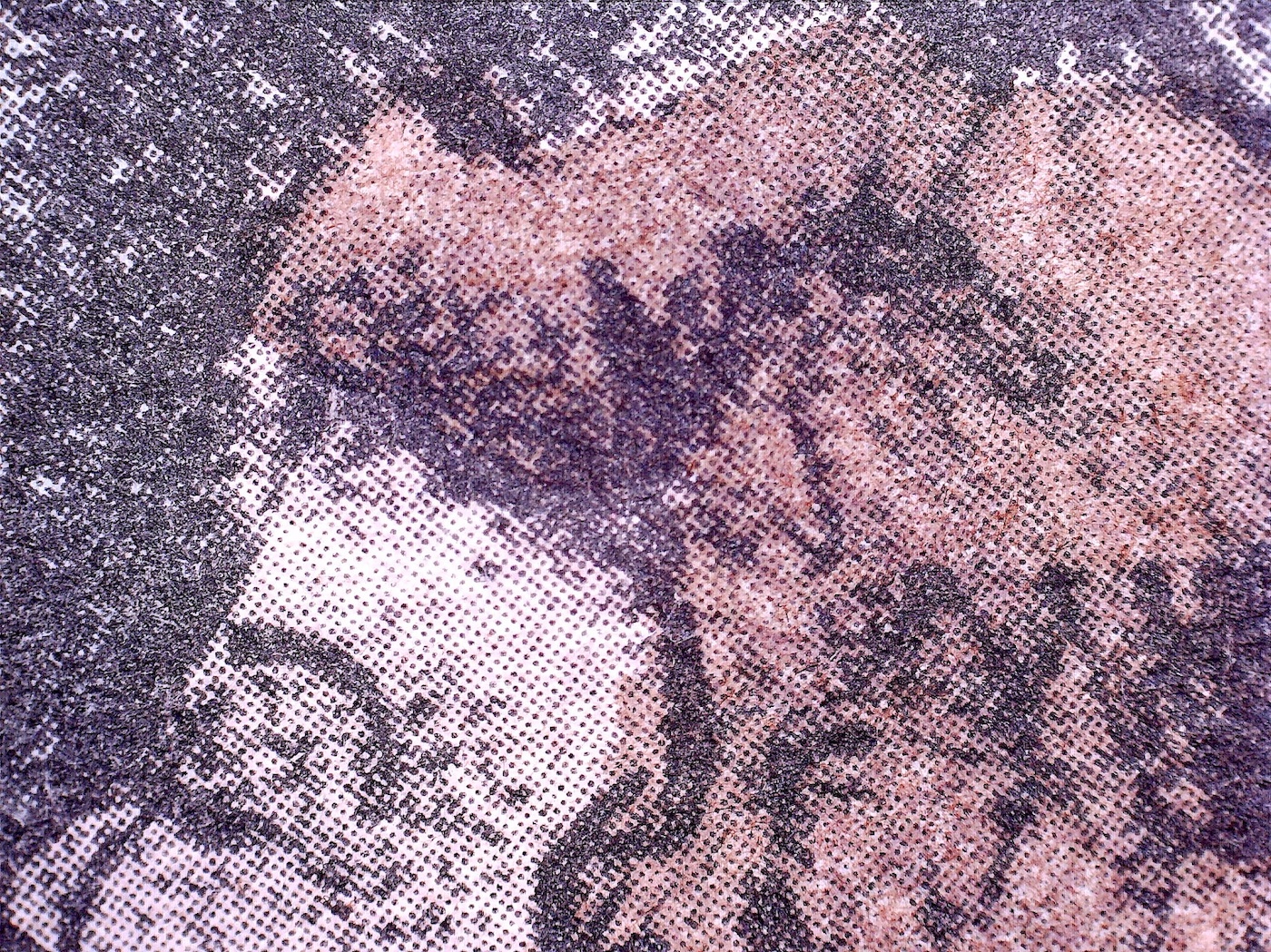 Micro photo of an etching:
Micro photo of an etching:
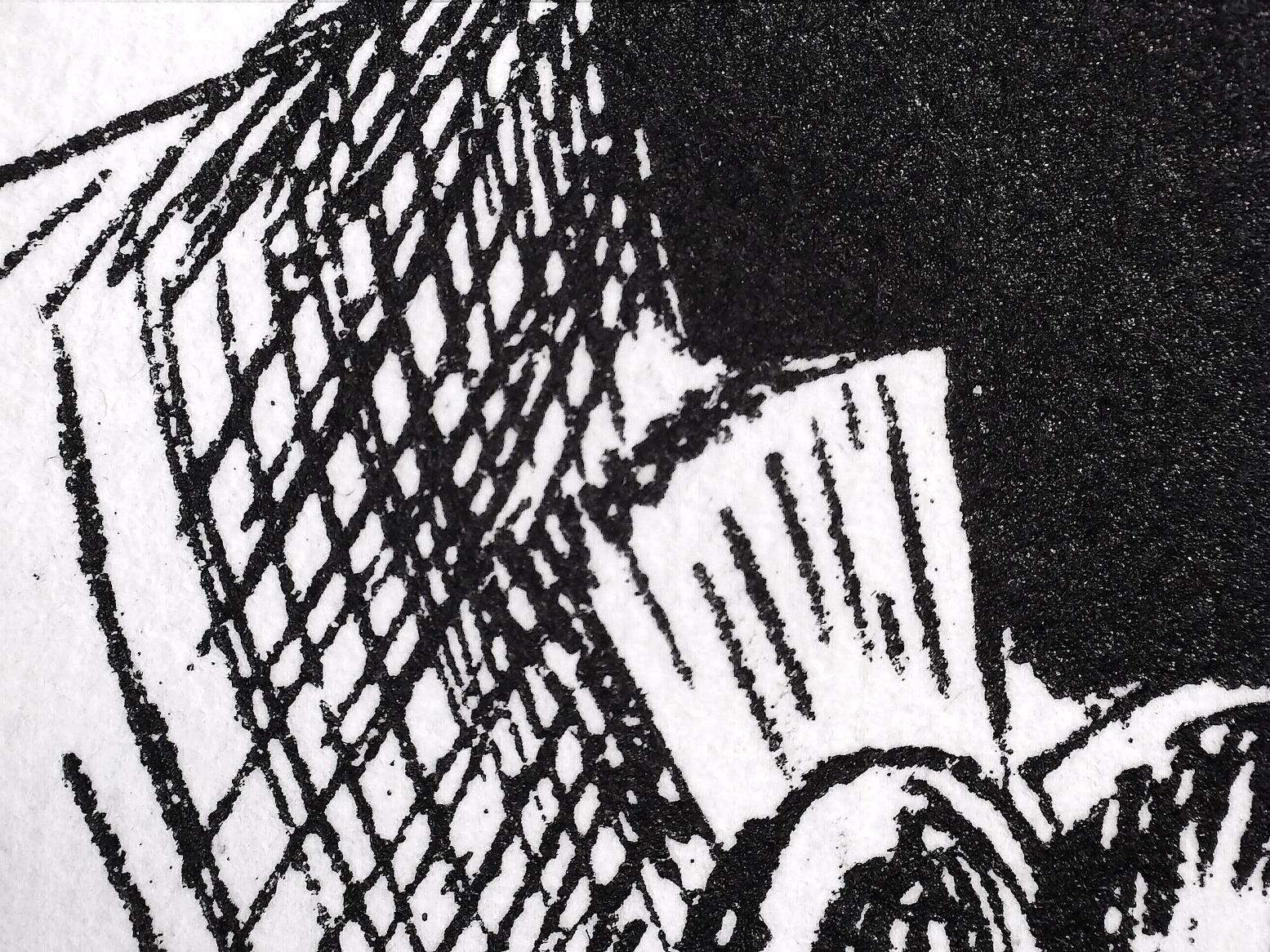
-
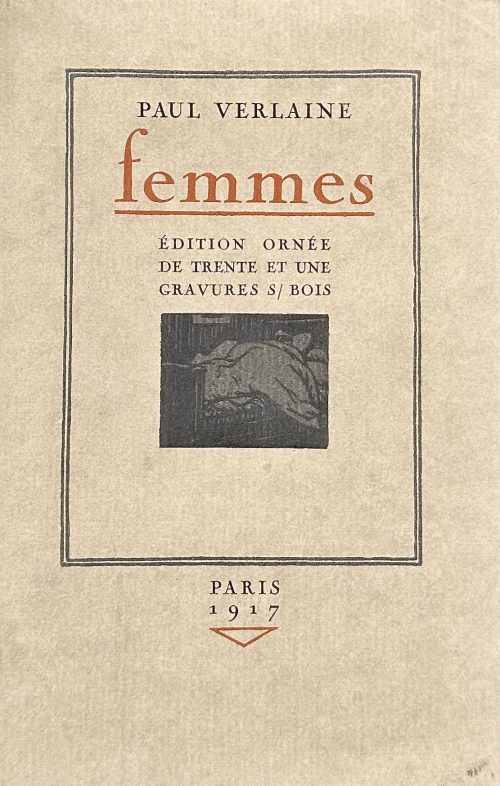 Softcover, 258 x 166 mm, publisher’s olive French flapped wrappers in owner’s glassine dustcover, edges untrimmed, some pages uncut, printed on thick wove paper with watermark “Hollande van Gelder Zonen”, in a slipcase. Pp.: [1-10] 11-129 [5], pages in wrappers included in the count, total 67 leaves; two-tone woodcuts by Jean-Gabriel Daragnès within the pagination. Title-page (red and black, in a double-fillet frame): PAUL VERLAINE | femmes | ÉDITION ORNÉE | DE TRENTE ET UNE | GRAVURES S/ BOIS | {vignette} | (under the bottom frame) PARIS | 1917 | {red triangle} || Limitation: Il a été tiré de cet ouvrage : 11 15 Exemplaires sur vieux papier de Japon numérotés de I à XV; 15 20 Exemplaires sur papier de Chine numérotés de XVI à XXXV; auxquels on a joint une suite des fumés sur même papier. 250 Exemplaires sur papier vélin de Hollande Van Gelder Zonen numérotés de 1 à 250. Après le tirage les bois ont été détruits. № 1. Numbers “15” and “20” corrected manually by Daragnès (per Dutel). This is copy № of vélin de Hollande print run. Catalogue raisonné: Dutel II: № 295; Nordmann II № 544. Seller’s description: Un volume broché in-8° sous couverture illustrée et rempliée. Etui cartonné. Illustré de 31 gravures sur bois en camaïeu, attribuées à DARAGNES, la plupart très libres, dont 18 à pleine page. Tiré à [226 ou 285] ex. numérotés. 1 des [200 ou 250] sur Hollande Van Gelder Zonen. Le nôtre porte le n°1. (Dutel : 295. Pia : 501. Carteret : IV, 392 : Belle édition rare, très estimée ». Monod : 11086). Dorgelès commenta ainsi ces illustrations : « Dans ces nus voluptueux et tragiques, qui semblent à la fois s’aimer et se haïr, on retrouve la même frénésie amère qui tourmente les poèmes interdits de Verlaine » (in Catalogue de livres... Daragnès, Drouot 1924, n°55). Très rares rousseurs. TRES BON EXEMPLAIRE, toujours recherché. Contributors: Paul Verlaine (French, 1844 – 1896) – author. Jean-Gabriel Daragnès (French, 1886 – 1950) – artist/publisher.
Softcover, 258 x 166 mm, publisher’s olive French flapped wrappers in owner’s glassine dustcover, edges untrimmed, some pages uncut, printed on thick wove paper with watermark “Hollande van Gelder Zonen”, in a slipcase. Pp.: [1-10] 11-129 [5], pages in wrappers included in the count, total 67 leaves; two-tone woodcuts by Jean-Gabriel Daragnès within the pagination. Title-page (red and black, in a double-fillet frame): PAUL VERLAINE | femmes | ÉDITION ORNÉE | DE TRENTE ET UNE | GRAVURES S/ BOIS | {vignette} | (under the bottom frame) PARIS | 1917 | {red triangle} || Limitation: Il a été tiré de cet ouvrage : 11 15 Exemplaires sur vieux papier de Japon numérotés de I à XV; 15 20 Exemplaires sur papier de Chine numérotés de XVI à XXXV; auxquels on a joint une suite des fumés sur même papier. 250 Exemplaires sur papier vélin de Hollande Van Gelder Zonen numérotés de 1 à 250. Après le tirage les bois ont été détruits. № 1. Numbers “15” and “20” corrected manually by Daragnès (per Dutel). This is copy № of vélin de Hollande print run. Catalogue raisonné: Dutel II: № 295; Nordmann II № 544. Seller’s description: Un volume broché in-8° sous couverture illustrée et rempliée. Etui cartonné. Illustré de 31 gravures sur bois en camaïeu, attribuées à DARAGNES, la plupart très libres, dont 18 à pleine page. Tiré à [226 ou 285] ex. numérotés. 1 des [200 ou 250] sur Hollande Van Gelder Zonen. Le nôtre porte le n°1. (Dutel : 295. Pia : 501. Carteret : IV, 392 : Belle édition rare, très estimée ». Monod : 11086). Dorgelès commenta ainsi ces illustrations : « Dans ces nus voluptueux et tragiques, qui semblent à la fois s’aimer et se haïr, on retrouve la même frénésie amère qui tourmente les poèmes interdits de Verlaine » (in Catalogue de livres... Daragnès, Drouot 1924, n°55). Très rares rousseurs. TRES BON EXEMPLAIRE, toujours recherché. Contributors: Paul Verlaine (French, 1844 – 1896) – author. Jean-Gabriel Daragnès (French, 1886 – 1950) – artist/publisher. -
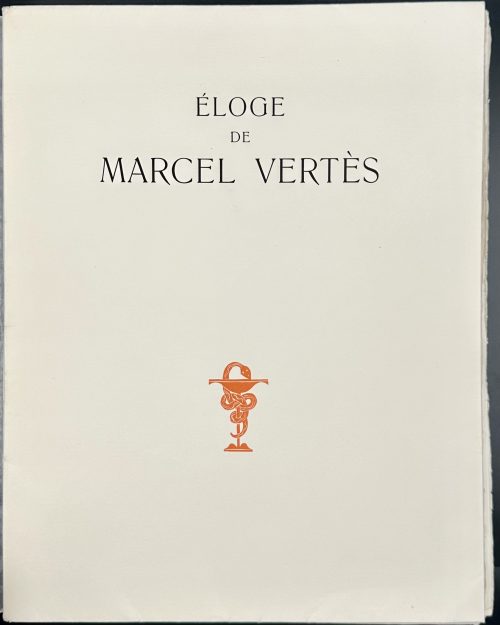 Softcover, 325 x 253 mm, publisher’s French flapped wrappers in glassine dust cover, 15 leaves folio folded in half, making 30 in-2o leaves 321 x 250 mm, with two leaves within the wrappers, [1] t.p., [2] Vertès’ blue ink inscription “À Alexaner Sternberg frère Nicolas qui est un garçon charmant et un bon artiste. Vertès.” and drawing, [3] frontispiece, [4-26] text with six full-page, one head- and one tailpiece in dry point technique, with guard tissues, [27] list of plates, [28] colophon, [29] blank; some page numbers manually scripted in pencil to the bottom right corners by a previous owner. Paper watermarked “BFK Rives”. Title-page (in orange and black): ÉLOGE | DE | MARCEL VERTÈS | PAR | GEORGES HUISMAN | ORNÉ | DE GRAVURES ORIGINALES | {publisher’s device} | MANUEL BRUKER ÉDITEUR || Colophon: CET OUVRAGE A ÉTÉ ACHEVÉ D'IMPRIMER SUR LES PRESSES DE L'IMPRIMERIE DARAGNÈS LE 30 OCTOBRE 1951 A 200 EXEMPLAIRES NUMÉROTÉS DONT 20 SUR VÉLIN 'ARCHES DE 1 A 20 AUXQUELS IL A ÉTÉ JOINT UNE SUITE DES GRAVURES SUR JAPON NACRÉ ET 180 SUR VÉLIN BLANC DE RIVES DE 21 A 200. ON A TIRÉ EN OUTRE 20 SUITES SUR MALACCA DES PLANCHES REFUSÉES. EXEMPLAIRE N° 93. Limitation: 200 copies printed on October 30, 1951, at Daragnès press: 20 (№№ 1-20) on Arches vellum paper with a suite of plates on Japon Nacré and 180 (№№ 21-200) Vélin Blanc by Rives. This is copy № 93. Tipped in: (1) photo of Vertès (and one more) in front of his murals, with the blue ballpoint pen inscription “À Alex Sternberg, frère de Nicola, excellent ami, excellent artiste et voyez, quel photographe!!! Vertès”; (2) postcard with a signed invitation to Vertès' exhibition by Librairie M.-P. Tremois: “Carte Postale | Paris, le 2 mars [19]28 | Monsieur, | Du 6 au 24 mars, | de 2 heures à 6h30, aura | lieu à la Librairie M.-P. Trémois | 43 avenue Rapp, 7e, une | exposition de dessins et | aquarelles de Vertès, ayant | servi à l’illustration de livres. | Nous espérons que vous | voudrez bien nous honorer | de votre visite. M.-P. Trémois.” The drypoint technique is confirmed by the presence of a white line in the middle of the black printed line on the micro photo:
Softcover, 325 x 253 mm, publisher’s French flapped wrappers in glassine dust cover, 15 leaves folio folded in half, making 30 in-2o leaves 321 x 250 mm, with two leaves within the wrappers, [1] t.p., [2] Vertès’ blue ink inscription “À Alexaner Sternberg frère Nicolas qui est un garçon charmant et un bon artiste. Vertès.” and drawing, [3] frontispiece, [4-26] text with six full-page, one head- and one tailpiece in dry point technique, with guard tissues, [27] list of plates, [28] colophon, [29] blank; some page numbers manually scripted in pencil to the bottom right corners by a previous owner. Paper watermarked “BFK Rives”. Title-page (in orange and black): ÉLOGE | DE | MARCEL VERTÈS | PAR | GEORGES HUISMAN | ORNÉ | DE GRAVURES ORIGINALES | {publisher’s device} | MANUEL BRUKER ÉDITEUR || Colophon: CET OUVRAGE A ÉTÉ ACHEVÉ D'IMPRIMER SUR LES PRESSES DE L'IMPRIMERIE DARAGNÈS LE 30 OCTOBRE 1951 A 200 EXEMPLAIRES NUMÉROTÉS DONT 20 SUR VÉLIN 'ARCHES DE 1 A 20 AUXQUELS IL A ÉTÉ JOINT UNE SUITE DES GRAVURES SUR JAPON NACRÉ ET 180 SUR VÉLIN BLANC DE RIVES DE 21 A 200. ON A TIRÉ EN OUTRE 20 SUITES SUR MALACCA DES PLANCHES REFUSÉES. EXEMPLAIRE N° 93. Limitation: 200 copies printed on October 30, 1951, at Daragnès press: 20 (№№ 1-20) on Arches vellum paper with a suite of plates on Japon Nacré and 180 (№№ 21-200) Vélin Blanc by Rives. This is copy № 93. Tipped in: (1) photo of Vertès (and one more) in front of his murals, with the blue ballpoint pen inscription “À Alex Sternberg, frère de Nicola, excellent ami, excellent artiste et voyez, quel photographe!!! Vertès”; (2) postcard with a signed invitation to Vertès' exhibition by Librairie M.-P. Tremois: “Carte Postale | Paris, le 2 mars [19]28 | Monsieur, | Du 6 au 24 mars, | de 2 heures à 6h30, aura | lieu à la Librairie M.-P. Trémois | 43 avenue Rapp, 7e, une | exposition de dessins et | aquarelles de Vertès, ayant | servi à l’illustration de livres. | Nous espérons que vous | voudrez bien nous honorer | de votre visite. M.-P. Trémois.” The drypoint technique is confirmed by the presence of a white line in the middle of the black printed line on the micro photo: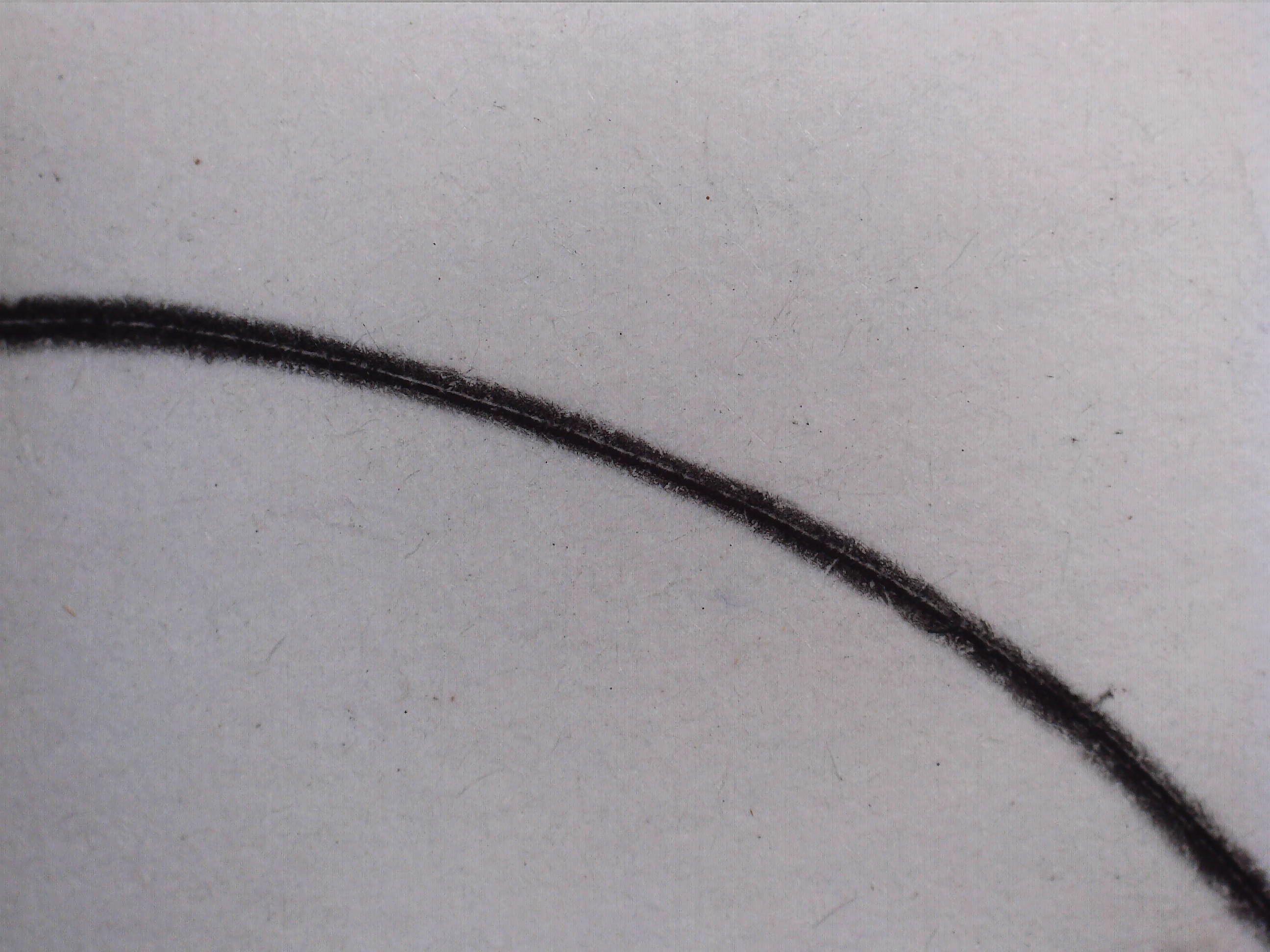 Catalogue raisonné: Vokaer № 52.
Contributors:
Georges Huisman (French, 1889 – 1957) – author.
Marcel Vertès [Marcell Vértes] (Jewish-Hungarian-French, 1895 – 1961) – character/artist.
Manuel Bruker (French, 1891 – 1979) – publisher.
Jean-Gabriel Daragnès (French, 1886 – 1950) – printer.
Nicolas Sternberg (Hungarian-French, 1902 –1960)
Librairie M.-P. Trémois (1925 – 1953)
Catalogue raisonné: Vokaer № 52.
Contributors:
Georges Huisman (French, 1889 – 1957) – author.
Marcel Vertès [Marcell Vértes] (Jewish-Hungarian-French, 1895 – 1961) – character/artist.
Manuel Bruker (French, 1891 – 1979) – publisher.
Jean-Gabriel Daragnès (French, 1886 – 1950) – printer.
Nicolas Sternberg (Hungarian-French, 1902 –1960)
Librairie M.-P. Trémois (1925 – 1953) -
 Two volumes, 168 x 106 mm each, uniformly bound in faux mottled calf ruled in gilt, marbled endpapers. Vol. 1: 3 blank leaves of wove paper, 3 blank leaves of laid paper, half-title/blank, blank/frontispiece, ‘engraved’ t.p./blank, both printed on laid paper watermarked “ARCHES A LA | MAIN”; ‘letterpress’ t.p.,/blank, pp.: [1] 2-115 [116 blank], 3 blank leaves of laid paper, 3 blank leaves of wove paper; collated 12mo: π2 A-I6 K4; total 60 leaves plus 16 ‘engraved’ plates, incl. t.p. and frontis. Vol. 2: 3 blank leaves of wove paper, 3 blank leaves of laid paper, half-title/blank, blank/frontispiece, ‘engraved’ t.p./blank, no watermark, ‘letterpress’ t.p.,/blank, pp.: 1-77 [78 blank], 2 blank leaves of laid paper, 3 blank leaves of wove paper; collated 12mo: π2 A-F6 G3; total 41 leaves plus 24 ‘engraved’ plates, incl. t.p. and frontis. Dutel (I): A-1089, p. 325: in-8 (probably by size only, no formula suggested), pagination 115 and 77 as here, 2 frontispieces, 2 engraved titles dated 1873, “et 36 belles gravures de Binet”. Cohen-DeRicci: p. 734 bottom: in-12, no pagination, no formula. "Thérèse" was offered by a French seller user-75d14f4 on the online auction platform CATAWIKI in December 2021. The seller's description of this two-volume set was: "Re-edition, the date of which I was unable to determine. (London, no name, 1782) 2 duodecimo volumes of 115 and 77 pp., very lovely marbled sheepskin pastiche bindings, gilded triple fillets, adorned spines, black title labels. This classic of 18th-century clandestine erotica was written in 1748 by an author who has remained anonymous, attributed at the time to Montigny, which led to his internment in the Bastille. It is now attributed to the Jean-Baptiste de Boyer, Marquis d'Argens. Edition illustrated with 37 very unrestrained figures, engraved in intaglio after Borel, unsigned." I should have paid more attention to the first phase, about the re-edition, but I didn't. After a few bidding rounds, I won the book when the hammer price was 2,200 Euros. On the 28th of December, 2021, I paid for this little beauty $2,760. The book arrived a few days later. The paper's quality and texture, the watermark, the absence of the platemark, and the lack of embossing on the back (text and plates) made me suspect it was a fake. The pages were absolutely flat to the touch! I established clear evidence of a high-resolution 'xerox' copy using Celestron Micro Capture Pro micro-photography. I wrote to the seller and the auction platform, explaining my doubts regarding its authenticity. To prove my point, I include a few micro photos of the "Thérèse" and some books printed at the end of the 18th century. I explained why I considered it a fake and requested a return/refund. After two months of email exchanges, the seller and the platform refused to pay me back. Today is the 2nd anniversary of the purchase. I still have the book. To celebrate my carelessness, I included it in my library to warn fellow book collectors about buying from an unknown dealer via certain online auction platforms. Ref.: Bamber Gascoigne. How to Identify Prints: A Complete Guide to Manual and Mechanical Processes from Woodcut to Ink. — Thames and Hudson, 1995.
Two volumes, 168 x 106 mm each, uniformly bound in faux mottled calf ruled in gilt, marbled endpapers. Vol. 1: 3 blank leaves of wove paper, 3 blank leaves of laid paper, half-title/blank, blank/frontispiece, ‘engraved’ t.p./blank, both printed on laid paper watermarked “ARCHES A LA | MAIN”; ‘letterpress’ t.p.,/blank, pp.: [1] 2-115 [116 blank], 3 blank leaves of laid paper, 3 blank leaves of wove paper; collated 12mo: π2 A-I6 K4; total 60 leaves plus 16 ‘engraved’ plates, incl. t.p. and frontis. Vol. 2: 3 blank leaves of wove paper, 3 blank leaves of laid paper, half-title/blank, blank/frontispiece, ‘engraved’ t.p./blank, no watermark, ‘letterpress’ t.p.,/blank, pp.: 1-77 [78 blank], 2 blank leaves of laid paper, 3 blank leaves of wove paper; collated 12mo: π2 A-F6 G3; total 41 leaves plus 24 ‘engraved’ plates, incl. t.p. and frontis. Dutel (I): A-1089, p. 325: in-8 (probably by size only, no formula suggested), pagination 115 and 77 as here, 2 frontispieces, 2 engraved titles dated 1873, “et 36 belles gravures de Binet”. Cohen-DeRicci: p. 734 bottom: in-12, no pagination, no formula. "Thérèse" was offered by a French seller user-75d14f4 on the online auction platform CATAWIKI in December 2021. The seller's description of this two-volume set was: "Re-edition, the date of which I was unable to determine. (London, no name, 1782) 2 duodecimo volumes of 115 and 77 pp., very lovely marbled sheepskin pastiche bindings, gilded triple fillets, adorned spines, black title labels. This classic of 18th-century clandestine erotica was written in 1748 by an author who has remained anonymous, attributed at the time to Montigny, which led to his internment in the Bastille. It is now attributed to the Jean-Baptiste de Boyer, Marquis d'Argens. Edition illustrated with 37 very unrestrained figures, engraved in intaglio after Borel, unsigned." I should have paid more attention to the first phase, about the re-edition, but I didn't. After a few bidding rounds, I won the book when the hammer price was 2,200 Euros. On the 28th of December, 2021, I paid for this little beauty $2,760. The book arrived a few days later. The paper's quality and texture, the watermark, the absence of the platemark, and the lack of embossing on the back (text and plates) made me suspect it was a fake. The pages were absolutely flat to the touch! I established clear evidence of a high-resolution 'xerox' copy using Celestron Micro Capture Pro micro-photography. I wrote to the seller and the auction platform, explaining my doubts regarding its authenticity. To prove my point, I include a few micro photos of the "Thérèse" and some books printed at the end of the 18th century. I explained why I considered it a fake and requested a return/refund. After two months of email exchanges, the seller and the platform refused to pay me back. Today is the 2nd anniversary of the purchase. I still have the book. To celebrate my carelessness, I included it in my library to warn fellow book collectors about buying from an unknown dealer via certain online auction platforms. Ref.: Bamber Gascoigne. How to Identify Prints: A Complete Guide to Manual and Mechanical Processes from Woodcut to Ink. — Thames and Hudson, 1995.
Books used for comparison: [LIB-2743.2021] Restif de la Bretonne. Les parisiennes, ou XL caractères généraux pris dans les mœurs actuelles, propres à servir à l’instruction des personnes-du-sexe / 4 vol. — Neufchâtel, et Paris: Guillot, 1787. [LIB-3027.2022] [Héliodore d’Emèse]. Amours de Théagènes et Chariclée: Histoire Éthiopique / 2 vol. — Londres [i.e. Paris]: [s.n.], 1743. [LIB-3252.2023] [Nicolas Chorier.] Le Meursius françois, ou entretiens galans d’Aloysia, orné de figures. — Cythere [i.e. Paris: Cazin], 1782. Below is a Xerox copy for comparison.Thérèse philosophe, 1783.
Late 18th century books
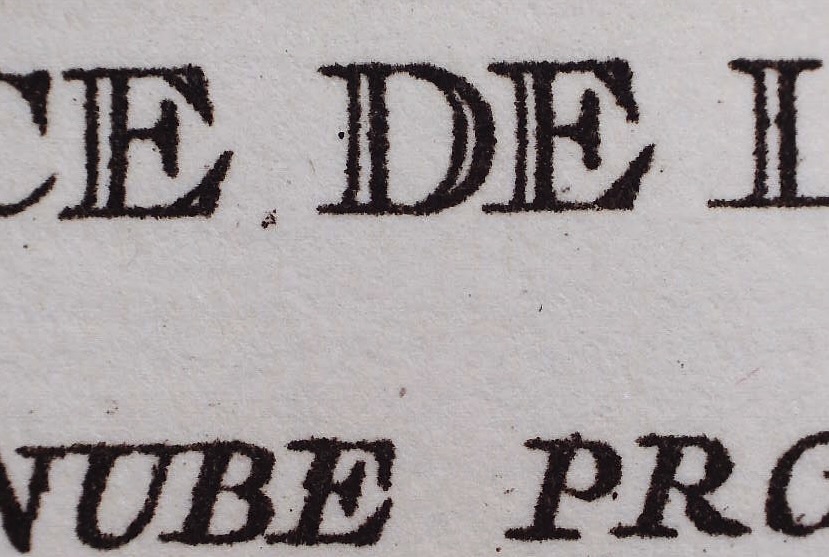
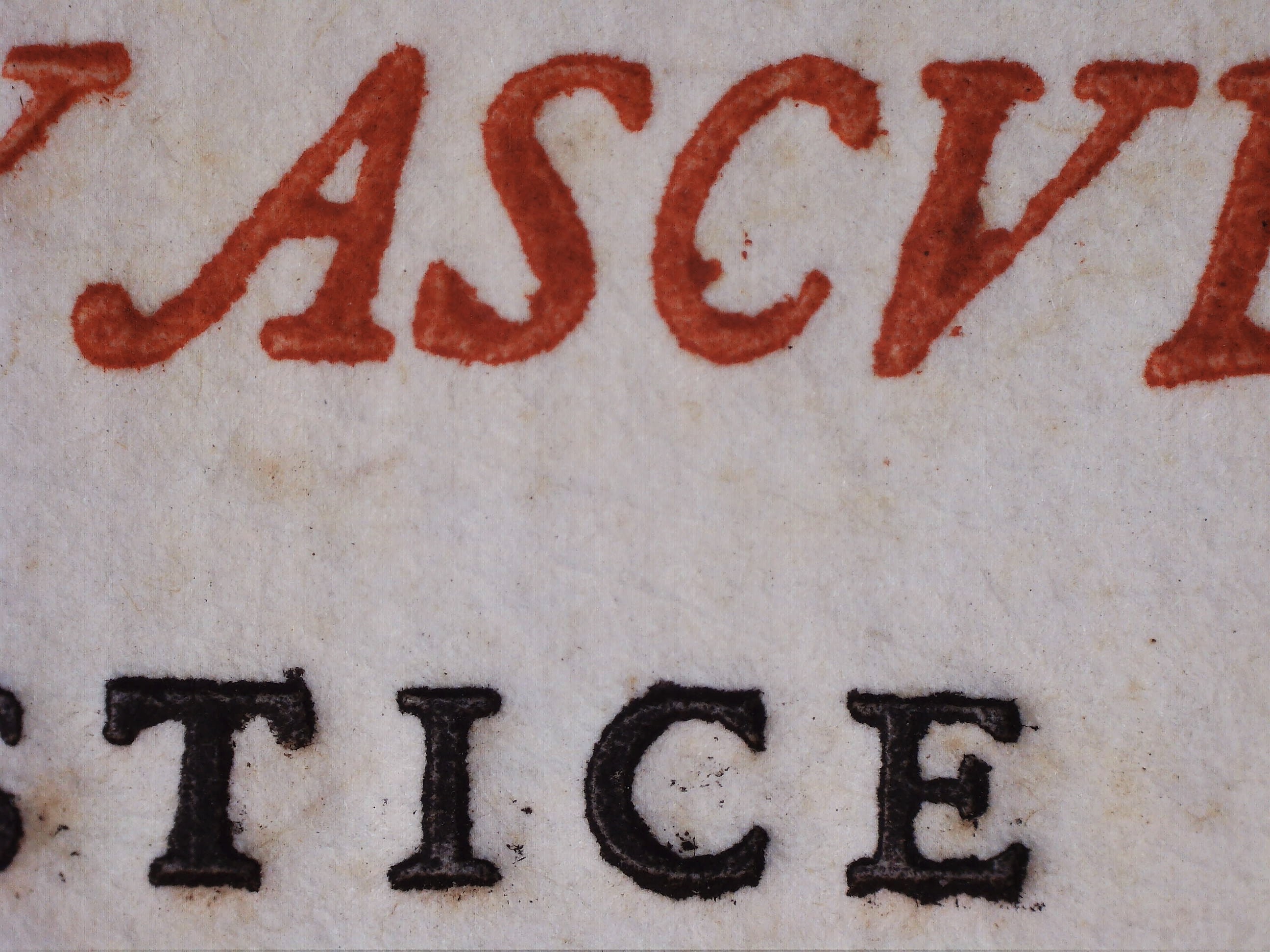
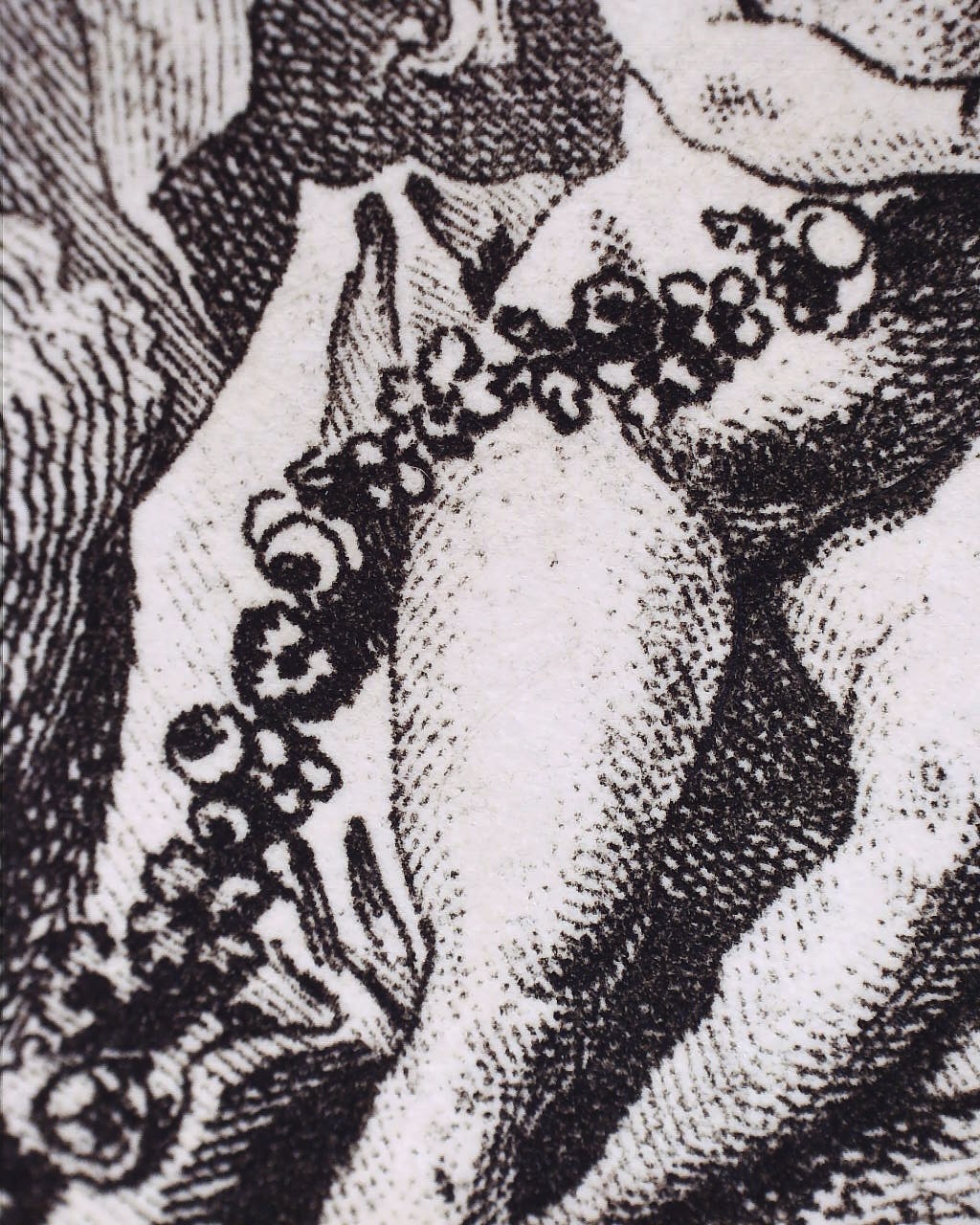
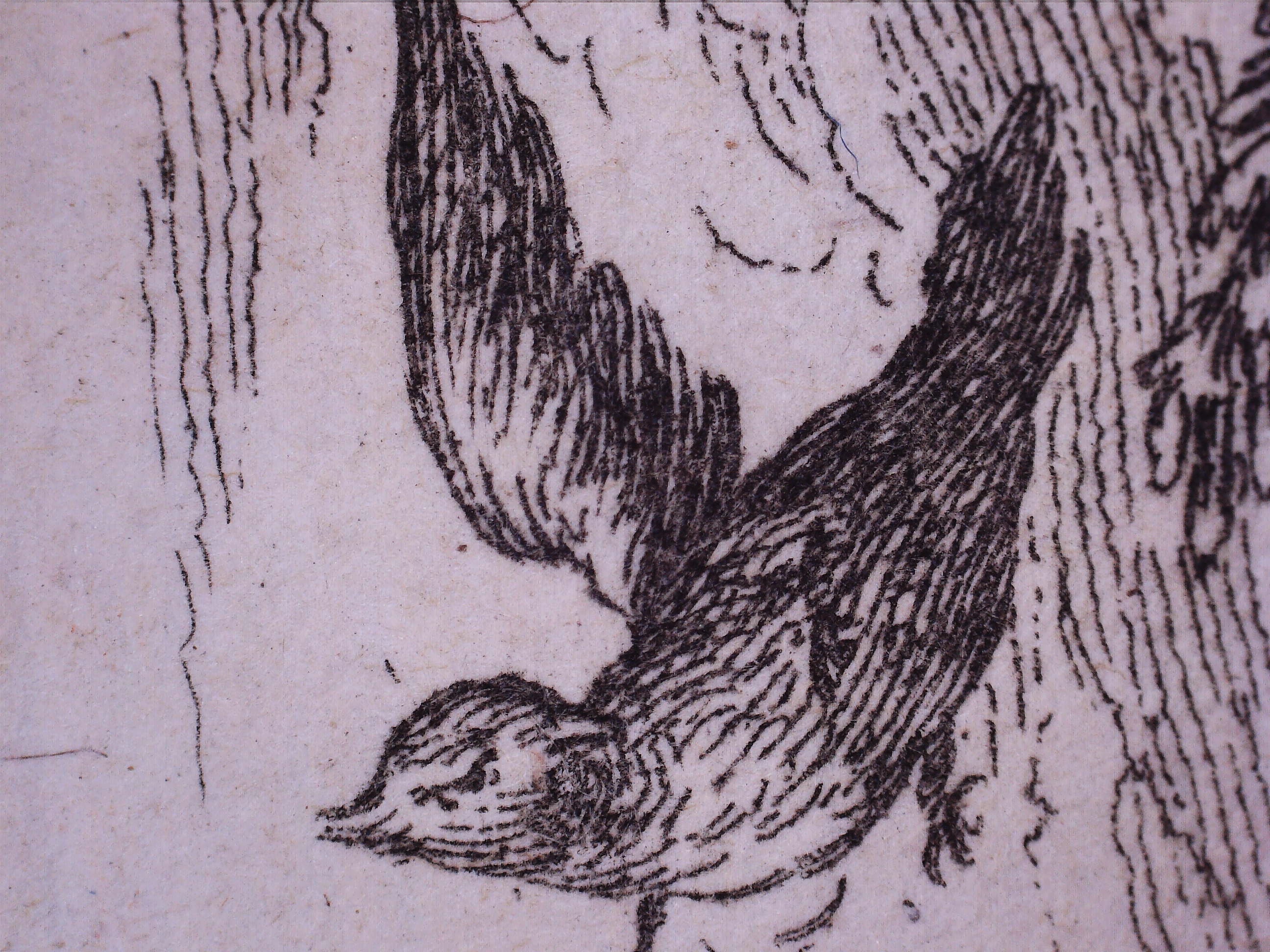
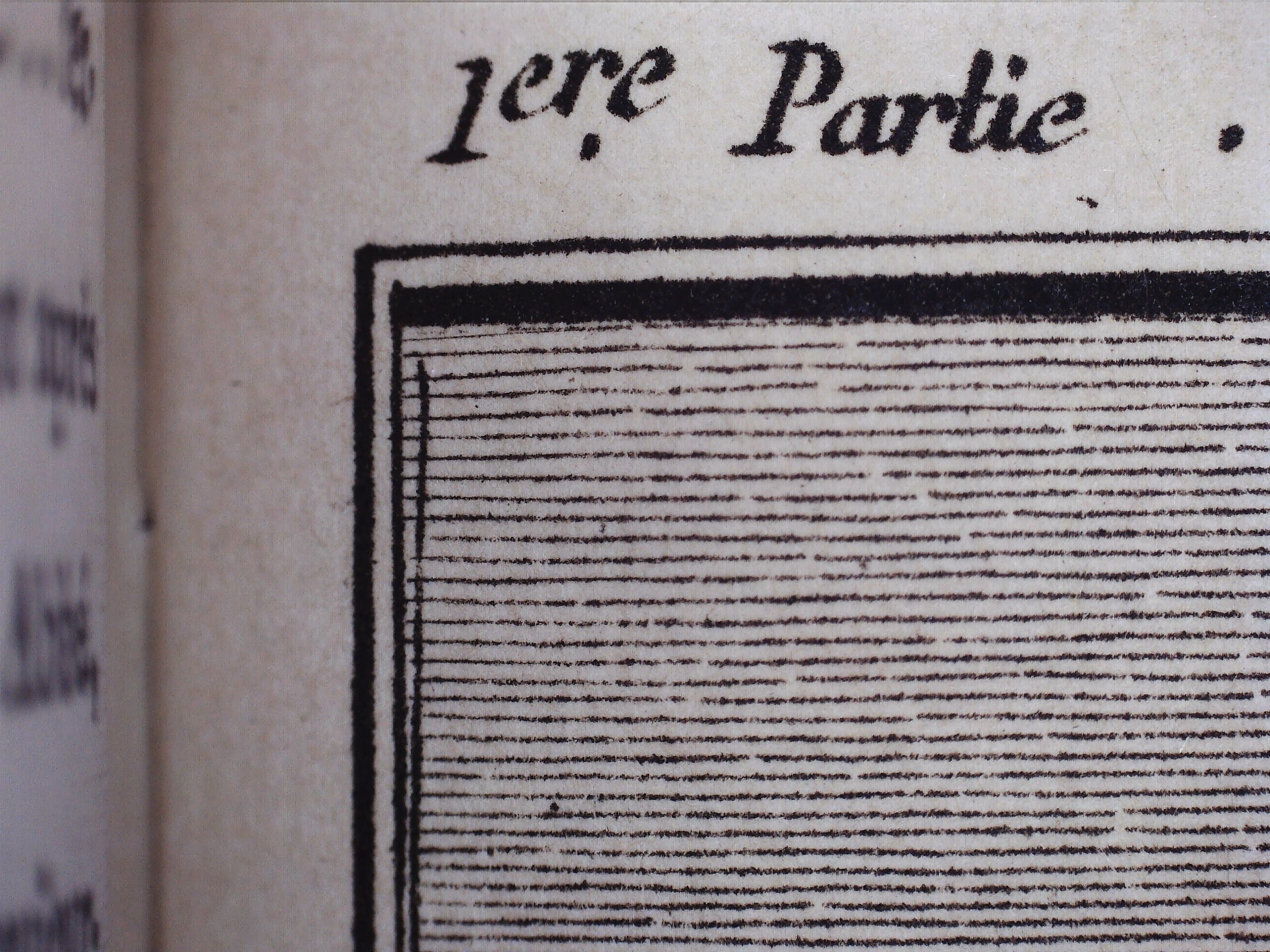
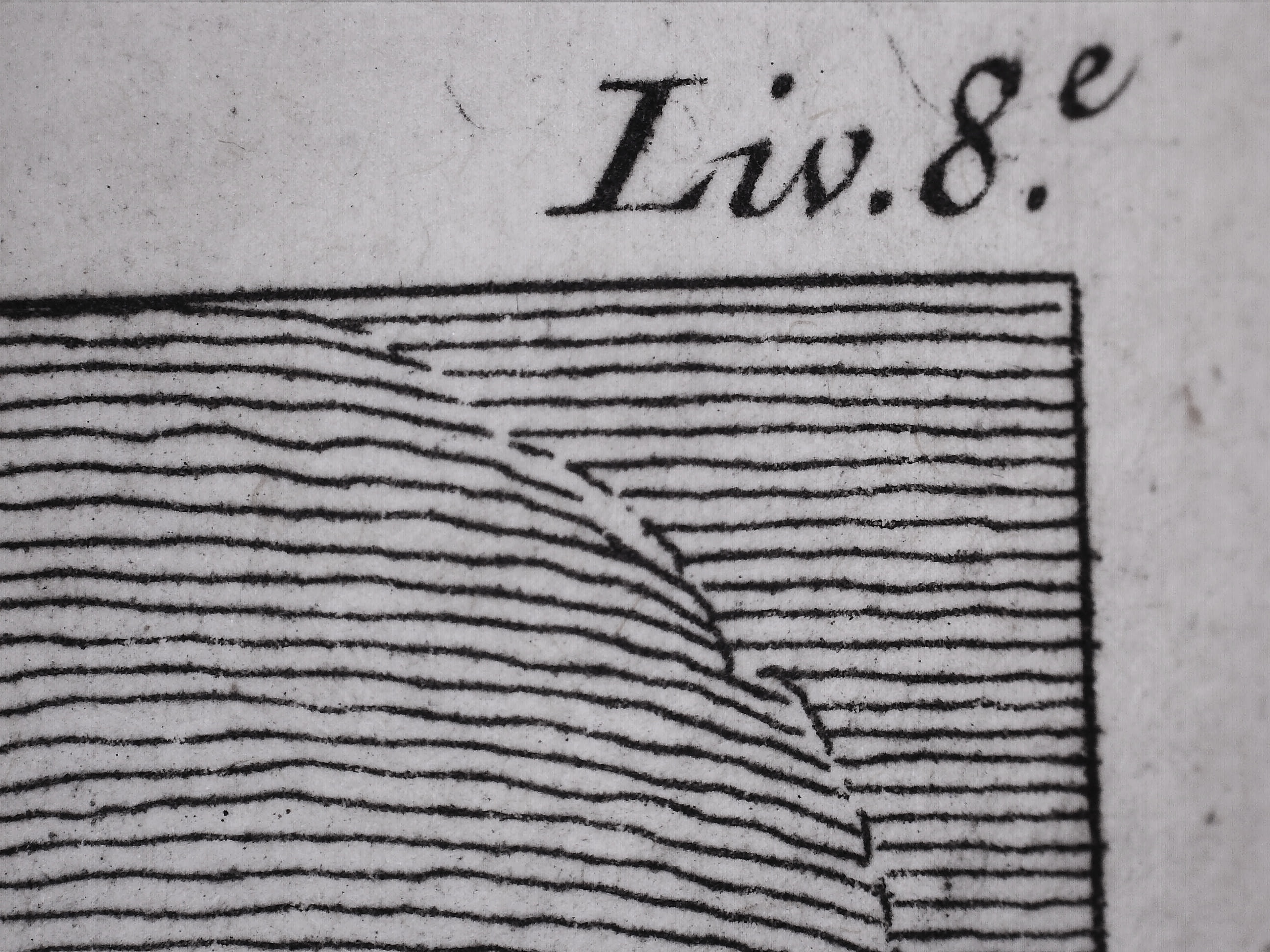
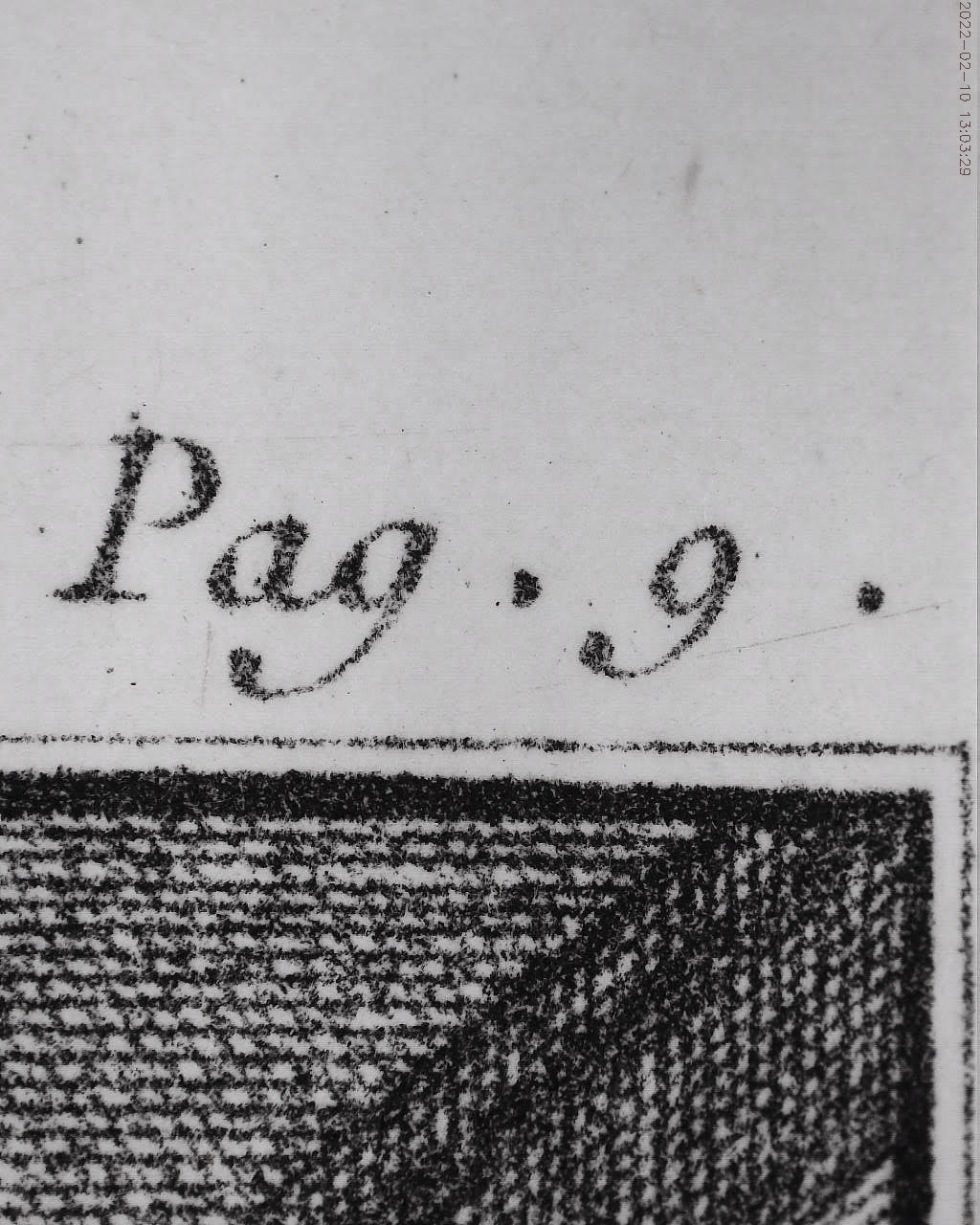
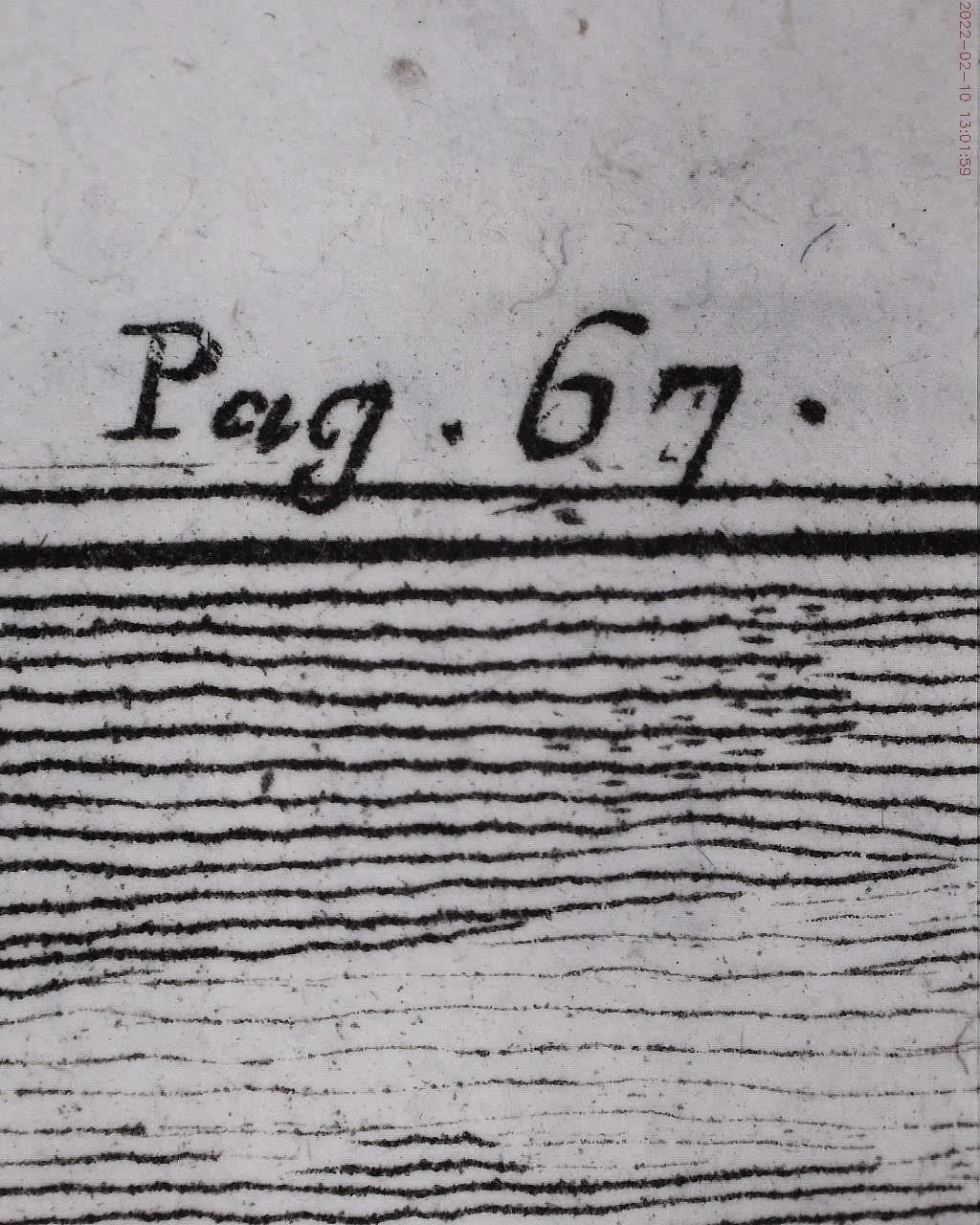

-
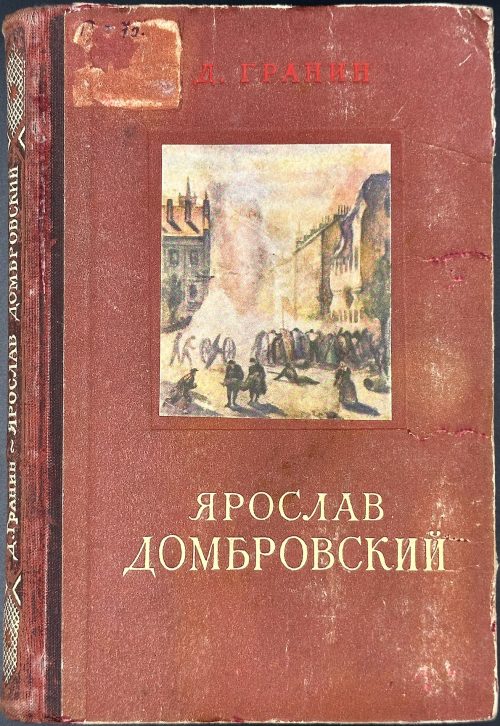 Hardcover, 20.4 x 14 cm, quarter burgundy cloth over paper boards with red and beige lettering and vignette to front and beige lettering to spine; pp.: [1-4] 5-182 [2], collation 8vo: 1-118 124, total 92 leaves. Design of binding and t.p. by В. Телепнев. Library pocket, stamps, and inscriptions. Title-page (red and black): Д. ГРАНИН | ЯРОСЛАВ | ДОМБРОВСКИЙ | ~ | ✸ | Издательство ЦК ВЛКСМ | “Молодая гвардия” | 1951 || Print run: 15,000 copies. Contributors: Даниил Александрович Гранин (Russian, 1919 – 2017) – author. Владимир Иванович Телепнев (Russian, 1906 – 1985) – artist. Jaroslaw Dombrowski [Jarosław Dąbrowski] (Polish-French, 1836 – 1871) – character.
Hardcover, 20.4 x 14 cm, quarter burgundy cloth over paper boards with red and beige lettering and vignette to front and beige lettering to spine; pp.: [1-4] 5-182 [2], collation 8vo: 1-118 124, total 92 leaves. Design of binding and t.p. by В. Телепнев. Library pocket, stamps, and inscriptions. Title-page (red and black): Д. ГРАНИН | ЯРОСЛАВ | ДОМБРОВСКИЙ | ~ | ✸ | Издательство ЦК ВЛКСМ | “Молодая гвардия” | 1951 || Print run: 15,000 copies. Contributors: Даниил Александрович Гранин (Russian, 1919 – 2017) – author. Владимир Иванович Телепнев (Russian, 1906 – 1985) – artist. Jaroslaw Dombrowski [Jarosław Dąbrowski] (Polish-French, 1836 – 1871) – character. -
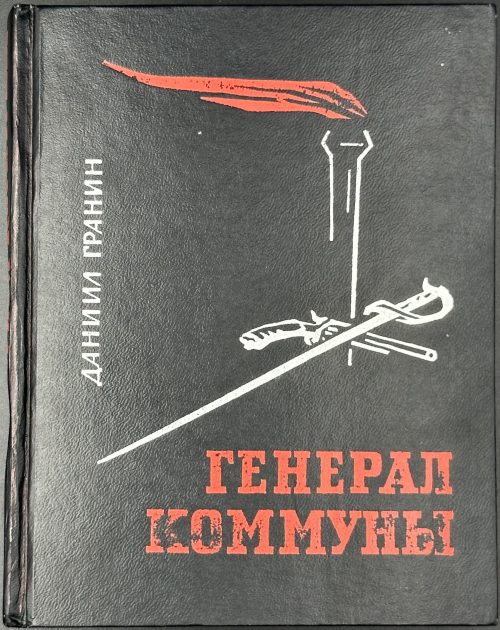 Hardcover, 17 x 13.4 cm, black buckram with red and silver vignette, lettering to front and spine, price and publisher's name embossed to back, pictorial endpapers with white lettering to red strips; pp.: [1-4] 5-268 [4], ils., collation: 16mo: 116 28 3-616 7-88 9-1016, total 136 leaves plus 3 photo plates after p. 32, 48, and 208. Frontispiece and in-text woodcuts after И. И. Старосельский. Title-page (red and black): ДАНИИЛ ГРАНИН | ГЕНЕРАЛ КОММУНЫ | (ЯРОСЛАВ ДОМБРОВСКИЙ) | — | Издательство | «СОВЕТСКАЯ РОССИЯ» | Москва — 1965 || Print run: 50,000 copies. Contributors: Даниил Александрович Гранин (Russian, 1919 – 2017) – author. Илья Израилевич Старосельский (Russian-Jewish, 1918 – 1968) – artist. Jaroslaw Dombrowski [Jarosław Dąbrowski] (Polish-French, 1836 – 1871) – character.
Hardcover, 17 x 13.4 cm, black buckram with red and silver vignette, lettering to front and spine, price and publisher's name embossed to back, pictorial endpapers with white lettering to red strips; pp.: [1-4] 5-268 [4], ils., collation: 16mo: 116 28 3-616 7-88 9-1016, total 136 leaves plus 3 photo plates after p. 32, 48, and 208. Frontispiece and in-text woodcuts after И. И. Старосельский. Title-page (red and black): ДАНИИЛ ГРАНИН | ГЕНЕРАЛ КОММУНЫ | (ЯРОСЛАВ ДОМБРОВСКИЙ) | — | Издательство | «СОВЕТСКАЯ РОССИЯ» | Москва — 1965 || Print run: 50,000 copies. Contributors: Даниил Александрович Гранин (Russian, 1919 – 2017) – author. Илья Израилевич Старосельский (Russian-Jewish, 1918 – 1968) – artist. Jaroslaw Dombrowski [Jarosław Dąbrowski] (Polish-French, 1836 – 1871) – character. -
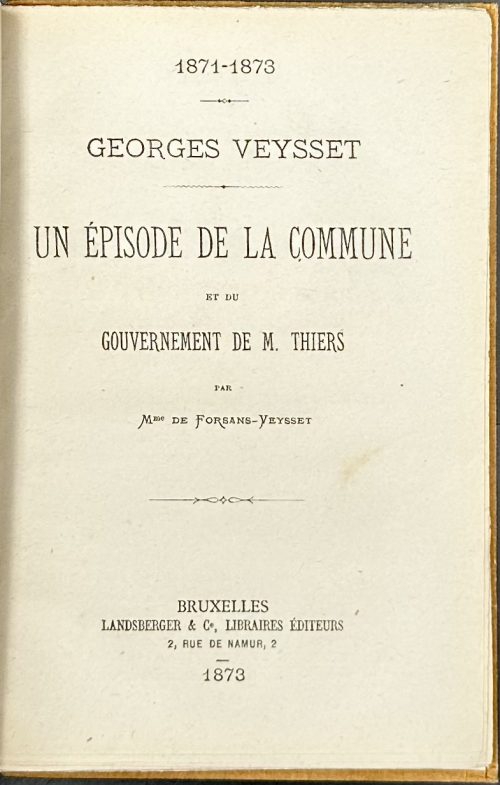 Owner’s hardcover, 182 x 120 mm, yellow buckram, crimson morocco label to spine with gilt lettering; publisher’s pink wrappers preserved, round engraved bookplate to front pastedown “DE LA BIBLIOTHÈQUE DE JULES RICHARD” cut to the border (“Imp. r. C. Motteroz” cut out); Pp.: [4] [1-5] 6-83 [84], various mss and printed clippings, 2 extra ffls to front and back. Title-page: 1871-1873 | — | GORGES VEYSSET | — | UN ÉPISODE DE LA COMMUNE | ET DU | GOUVERNEMENT DE M. THIERS | PAR | Mme DE FORSANS-YEYSSET | — | BRUXELLES | LANDSBERGER & C°, LIBRAIRES ÉDITEURS | 2, RUE DE NAMUR, 2 | 1873 || Provenance: Jules Richard (French, 1848 – 1930). Ref: BNF.
Owner’s hardcover, 182 x 120 mm, yellow buckram, crimson morocco label to spine with gilt lettering; publisher’s pink wrappers preserved, round engraved bookplate to front pastedown “DE LA BIBLIOTHÈQUE DE JULES RICHARD” cut to the border (“Imp. r. C. Motteroz” cut out); Pp.: [4] [1-5] 6-83 [84], various mss and printed clippings, 2 extra ffls to front and back. Title-page: 1871-1873 | — | GORGES VEYSSET | — | UN ÉPISODE DE LA COMMUNE | ET DU | GOUVERNEMENT DE M. THIERS | PAR | Mme DE FORSANS-YEYSSET | — | BRUXELLES | LANDSBERGER & C°, LIBRAIRES ÉDITEURS | 2, RUE DE NAMUR, 2 | 1873 || Provenance: Jules Richard (French, 1848 – 1930). Ref: BNF. -
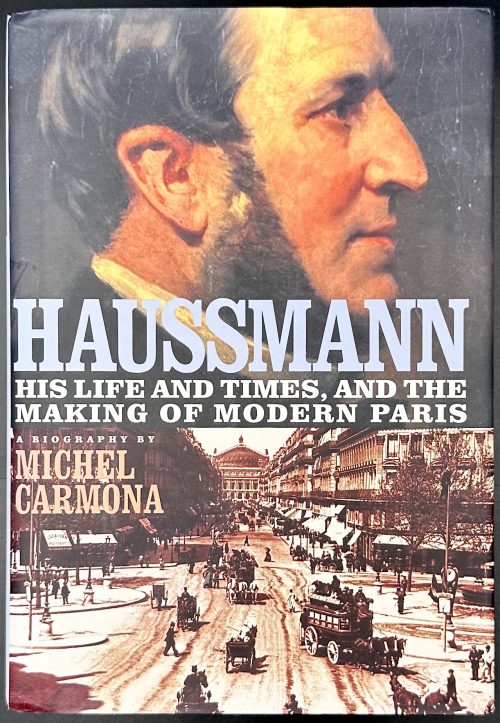 Hardcover, 242 x 168 mm, quarter burgundy cloth over blue paper boards, outer edge untrimmed; pp.: [6] [1-4] 5-516 [2 colophon/blank] [6 blanks]. First published in France in 2000 as “Haussmann” by Librairie Arthème Fayard. Title-page: HAUSSMANN | ~ | His Life and Times, | and the Making of Modern Paris | MICHEL CARMONA | TRANSLATED FROM THE FRENCH BY PATRICK CAMILER | {publisher’s device} | Ivan • R • Dee | Chicago 2002 || Michel Carmona (French, b. 1940) Georges-Eugène Haussmann [Baron Haussmann] (French, 1809 – 1891)
Hardcover, 242 x 168 mm, quarter burgundy cloth over blue paper boards, outer edge untrimmed; pp.: [6] [1-4] 5-516 [2 colophon/blank] [6 blanks]. First published in France in 2000 as “Haussmann” by Librairie Arthème Fayard. Title-page: HAUSSMANN | ~ | His Life and Times, | and the Making of Modern Paris | MICHEL CARMONA | TRANSLATED FROM THE FRENCH BY PATRICK CAMILER | {publisher’s device} | Ivan • R • Dee | Chicago 2002 || Michel Carmona (French, b. 1940) Georges-Eugène Haussmann [Baron Haussmann] (French, 1809 – 1891)


